Moritz Pillischer, ~1819 - 1893
Jacob “James” Pillischer, 1838 - 1930
by Brian Stevenson
last updated April, 2018
Moritz Pillischer emigrated from Hungary to London, England in 1845. He opened an independent shop that produced microscopes and other scientific and mathematical instruments in about 1849. While his instruments were not quite as precise as the top three English makers (Powell and Lealand, Ross, and Smith, Beck & Beck), they were widely considered to be nearly as good as those makers’ products, but at a fraction of the price. The quality of Pillischer microscopes is reflected by the numerous prizes awarded at international exhibitions, which are noted on the labels of microscope slides sold by Pillischer. Moritz’s nephew, Jacob (who adopted the name “James”), moved to London around 1860 to work for his uncle. Jacob later became Moritz’s son-in-law, after marrying one of his daughters. Moritz handed over ownership of the business to Jacob in 1887. The company was later inherited by Jacob’s children, and the business was liquidated in 1947.
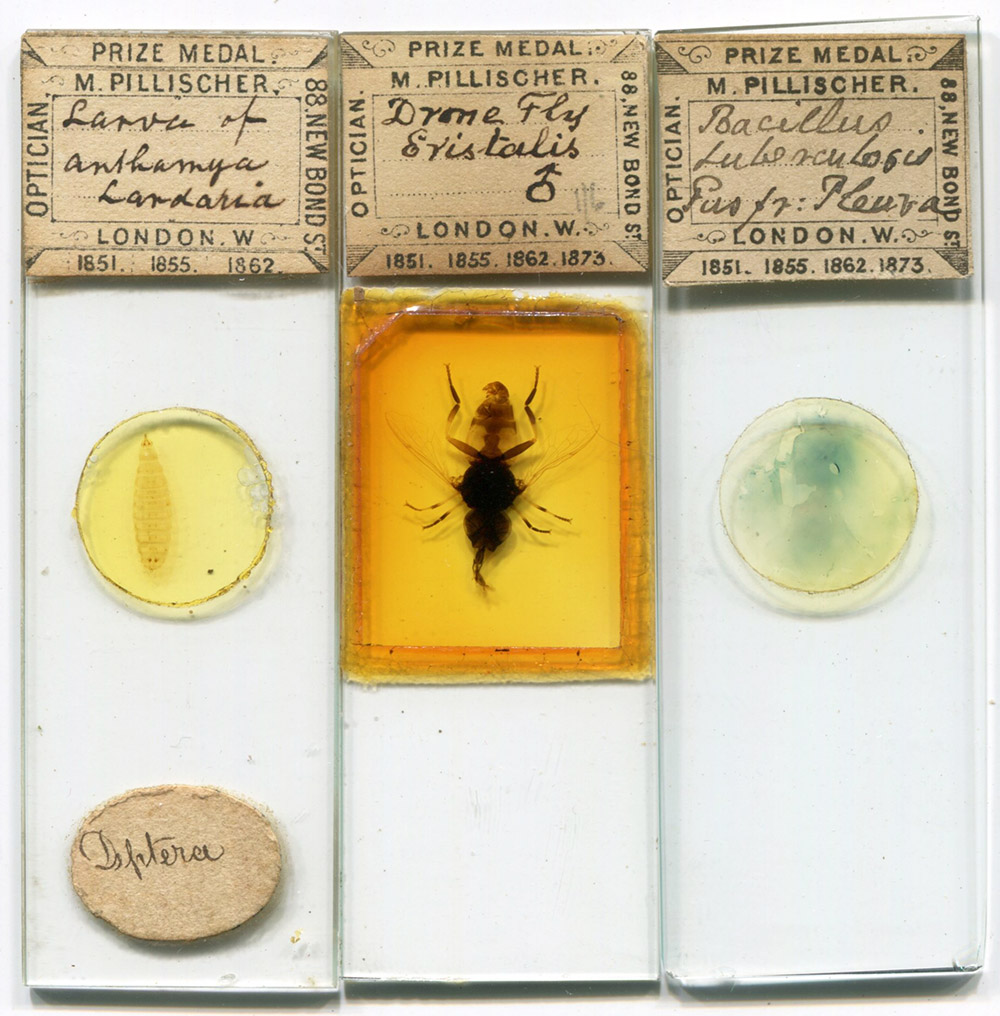
Figure 1.
Microscope slides that were retailed by Moritz Pillischer. While it is likely that the majority of such slides were brought in from outside makers, some slides were made on the premises: in her 1894 “Observations of Injurious Insects and Common Farm Pests”, E.A. Ormerod wrote that, “microscopic slides were prepared for me from quite fresh specimens by Mr. J. Pillischer (optician), of 88, New Bond Street, London” (not necessarily meaning that Pillischer made them himself). The dates indicate international expositions where Pillischer won awards: 1851 London, 1855 Paris, 1862 London, and 1873 Vienna. The award dates of prizes give ranges of when they were sold: the left slide was sold between 1862 and 1873, and the other two after 1873.
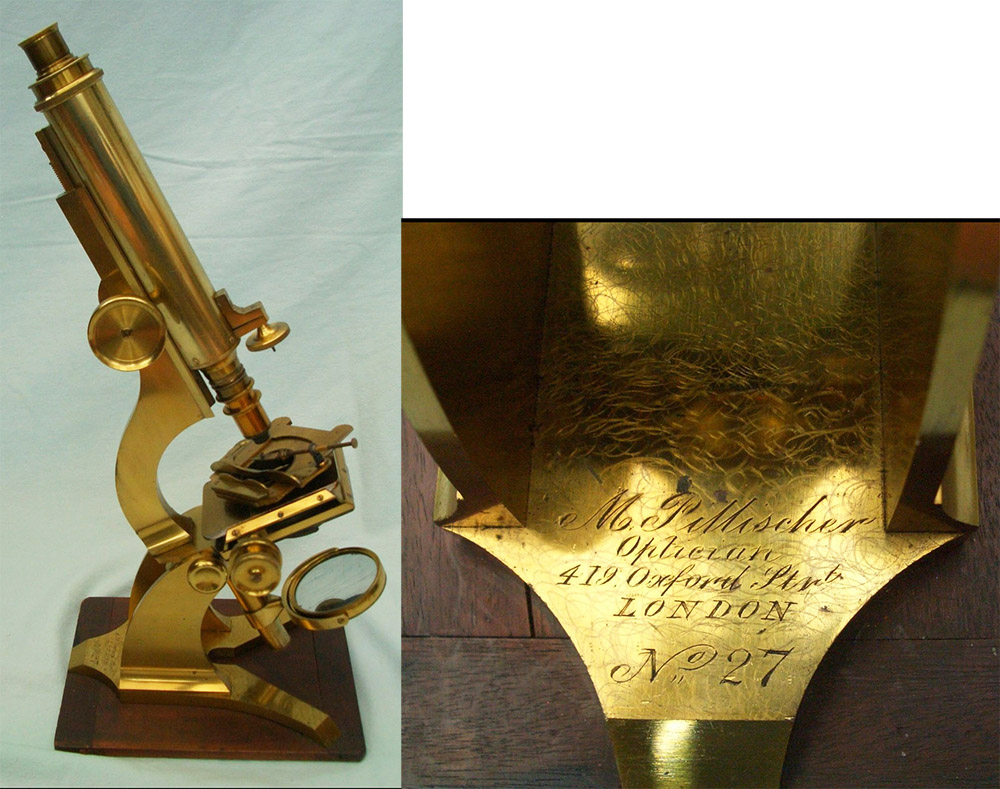
Figure 2.
Moritz Pillischer microscope number 27, made ca. 1850, shortly after he established his independent optical business at 419 Oxford Street. Adapted for nonprofit, educational purposes from an internet auction site.
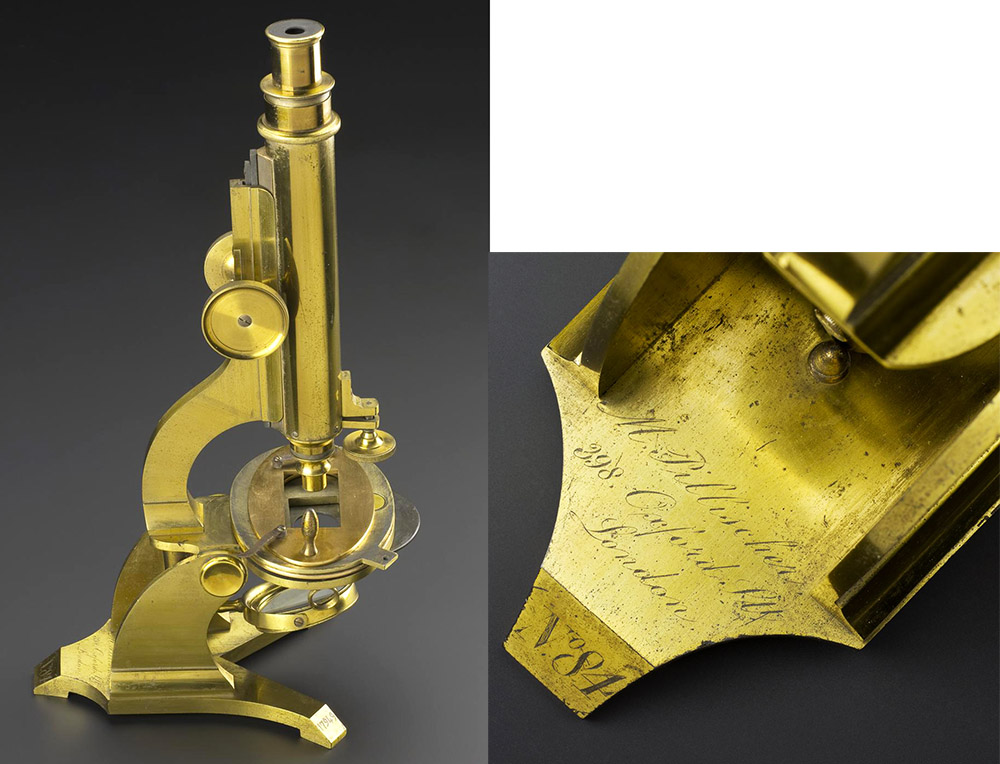
Figure 3.
Pillischer microscope number 84, made after his move to 398 Oxford Street. The relocation/renumbering occurred before the spring of 1851. Adapted for nonprofit, educational purposes from http://collection.sciencemuseum.org.uk/objects/co118847/compound-monocular-microscope-with-oval-stage-by-compound-monocular-microscopes.

Figure 4.
Pillischer included a Tomes-type stage on many of his early compound microscopes. Shown here on microscope number 182, three eccentrically-linked ovals allowed the microscopist to move a specimen horizontally and vertically, and rotating over 90 degrees in either direction. The Tomes stage lost popularity by the mid-1850s, replaced by the more precise rack-and-pinion mechanical stages. Microscope number 182 does not bear an address, and presumably was made after the 1853 move to 88 New Bond Street. The next-lowest numbered Pillischer microscope that is known, number 167, bears the earlier address of 398 Oxford Street.
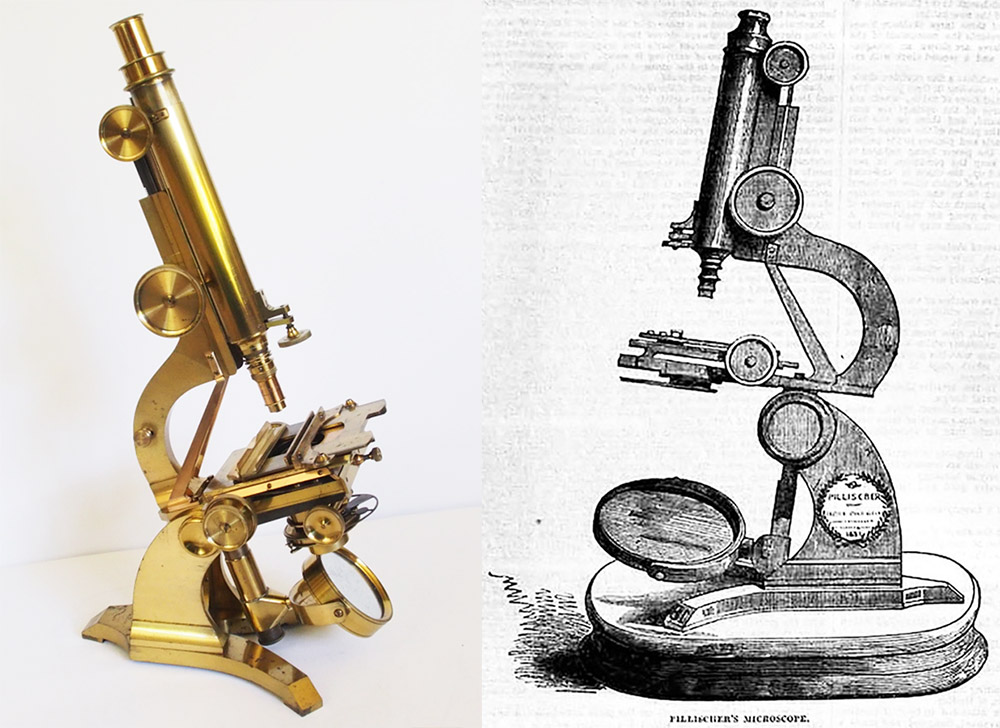
Figure 5.
(Left) A ca. 1851 version of Pillischer’s large microscope, having a rackwork drawtube and support trusses on the limb. (Right) A print of this model of microscope, from an article on Pillischer’s contributions to the 1851 London Exhibition, from “The Illustrated London News”. The Jury described it as “a large microscope stand, which is good for its price, but unnecessarily large and inconvenient for use”. This image of the surviving microscope was generously provided by Jurriaan de Groot.
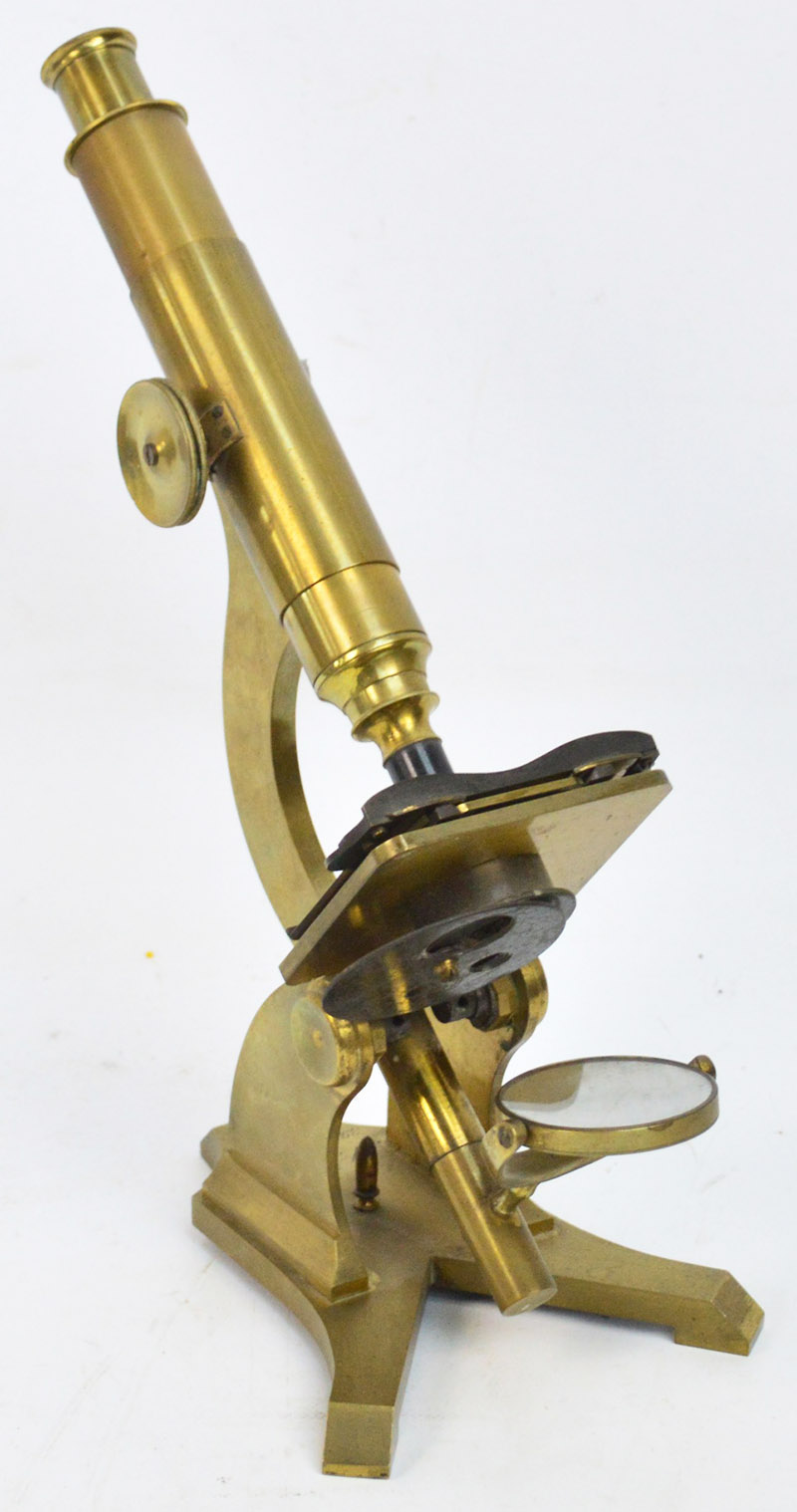
Figure 6.
An early Pillischer “Student” microscope, circa 1852. This inexpensive model was made without a fine focus, and has a simple stage. Adapted for nonprofit, educational purposes from an internet auction site.

Figure 7.
(Left and Center) A Pillischer “lenticular” microscope, serial number 153. Manufactured ca. 1854. This model was not inscribed with Pillischer’s address, and appears to have its own set of serial numbers, independent of his compound microscopes. The lenticular was not shown at the 1851 London Exhibition, nor was it described in Quekett’s 1852 edition of “A Practical Treatise on the Use of the Microscope”. (Right) Illustration from Golding Bird’s 1853 fourth edition of “Urinary Deposits”. Bird did not mention the lenticular microscope in his third, 1851 edition. Pillischer was advertising his lenticular microscope in January, 1853. Of note, Bird’s 1853 illustration is of the second form, which has a wheel of stops - the first version did not have an adjustable substage. These suggest that the lenticular microscope was initially produced during 1852, possibly late 1851. A detailed analysis of the four versions of Pillischer’s lenticular microscope may be read at http://www.microscope-antiques.com/pilllentic.html. The photographs in this figure were adapted from that site, for nonprofit, educational purposes.
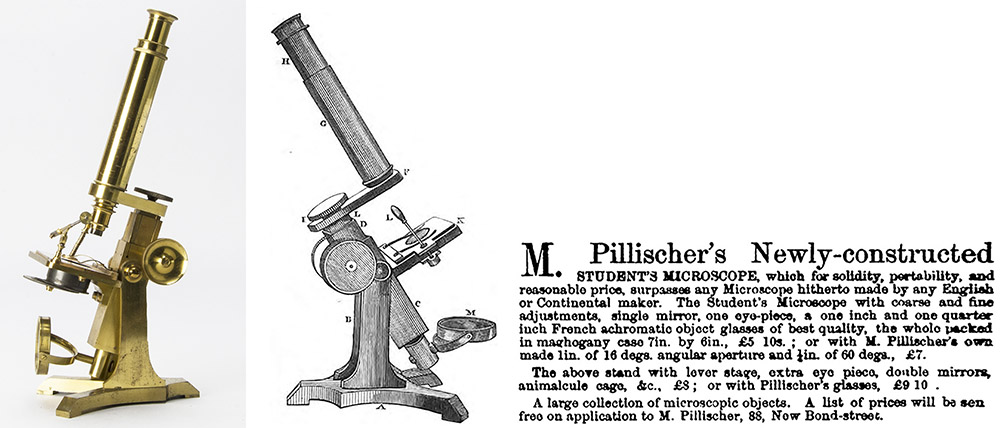
Figure 8.
Pillischer introduced a new form of “Student” microscope in late 1854. Quekett (1855) described the limb: “A stout square tube has two smaller square tubes sliding within it; one of these is moved up and down by rack and pinion, forming the coarse adjustment; the other being slowly raised or depressed by the screw constituting the fine adjustment. The stage is furnished with an object-plate, capable of being moved about in various directions by a short lever. The mirror is a double one and has all the usual movements; it is attached by a short cylinder to the base of the square tube”.
(Left) A Pillischer “Student” microscope, serial number 703. Note the “Varley”-type stage, as described by Quekett.
(Center) Diagram from Quekett’s 1855, third edition of “A Practical Treatise on the Use of the Microscope”.
(Right) November, 1853, advertisement for this model, from “The Medical Times and Gazette”. Photograph of microscope adapted for nonprofit, educational purposes from an internet auction site.
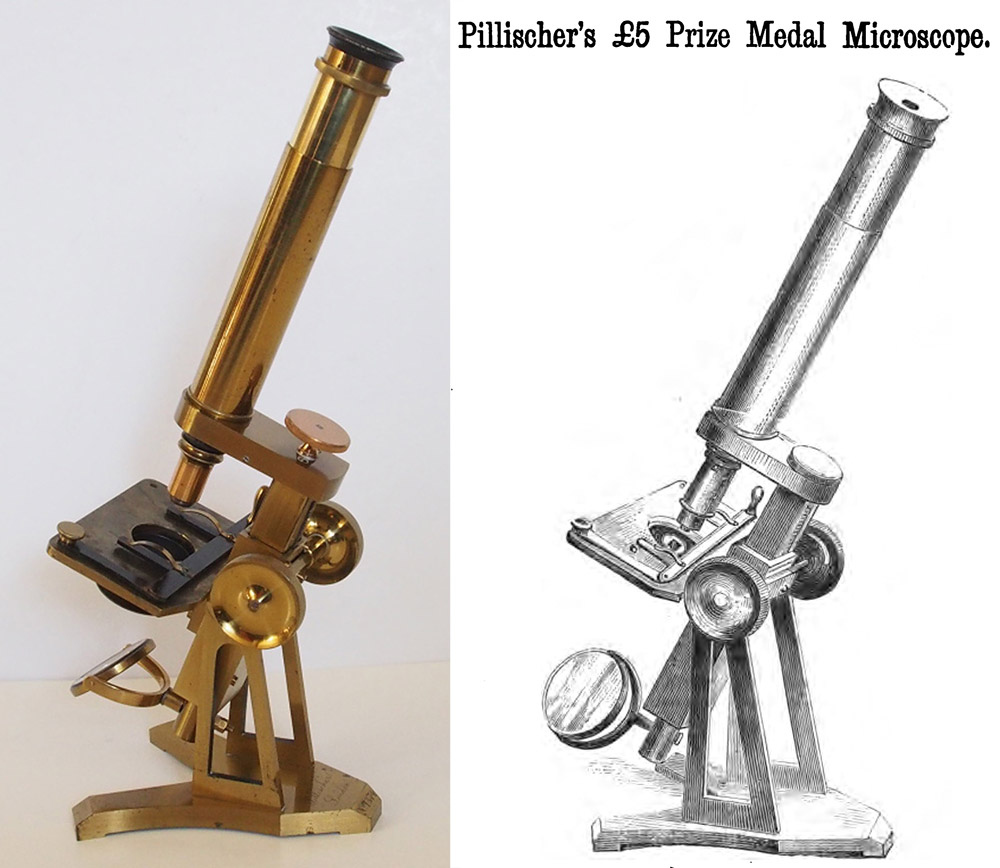
Figure 9.
�Pillischer’s “£5 Microscope”. The earliest descriptions are from the 1862 London Exhibition. After winning medals there, Pillischer renamed it the “£5 Prize Microscope”. The image at left was adapted by permission from Jurriaan de Groot. The right image is from Pillischer’s 1873 catalogue.
���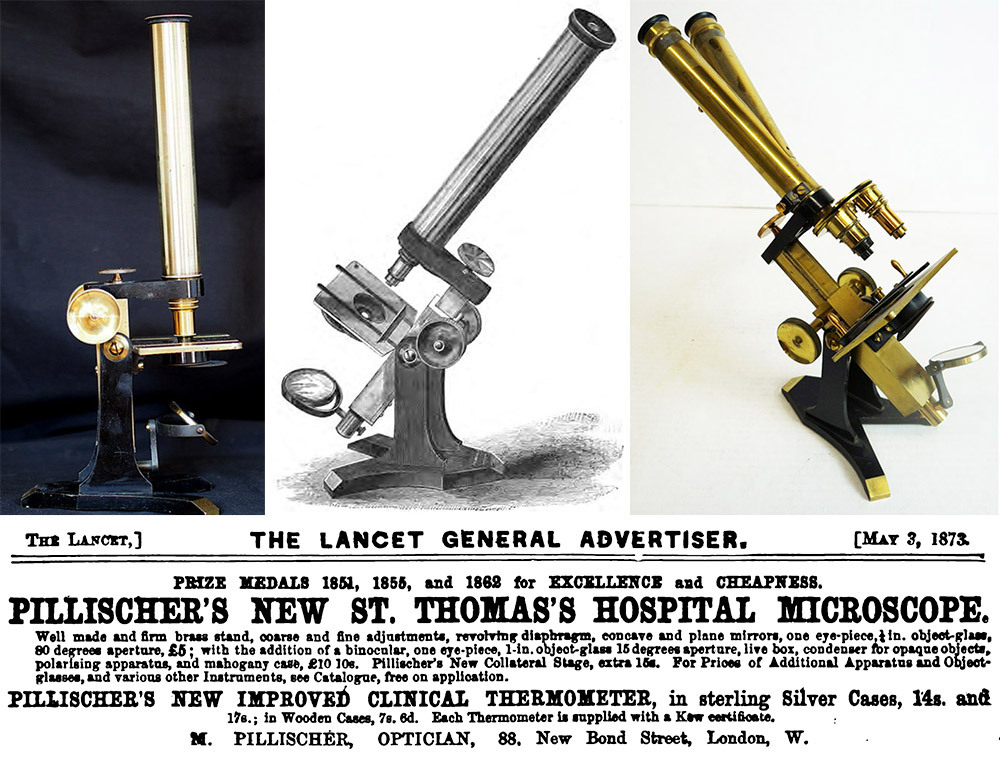
Figure 10.
Two Pillischer microscopes that match the description of his “St. Thomas Hospital” model, introduced in 1873 (as noted in the advertisement from “The Lancet”). The center illustration is from his 1873 catalogue. The foot, trunions, and arm are blackened, while the remainder is lacquered brass. The catalog example has a slide-holder that slides in two grooves in the stage, as does the example on the left. The binocular example on the right has Pillischer’s “Collateral” mechanical stage, which cost an extra 15 shillings. The left microscope has serial number 1748, the serial number of the right microscope is not known. Both photographs are adapted for nonprofit, educational purposes from internet auction sites.
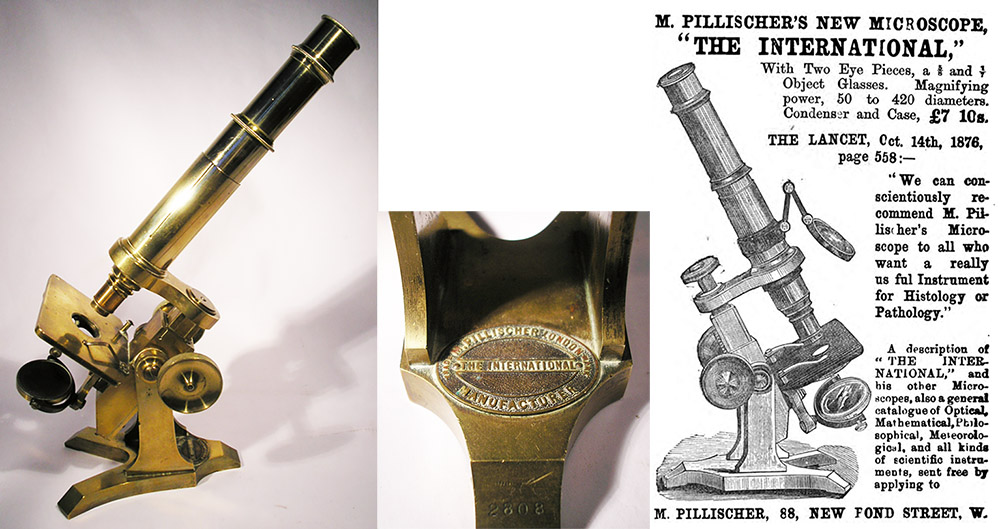
Figure 11.
Pillischer introduced “The International” in 1876. The name derives from its featuring a body tube that is of the English standard length, but which can be drawn out to the “Continental” standard length. William B. Carpenter wrote in 1881, “The Student who may be willing to incur a slight additional expense, for the sake of obtaining a substantial and well-constructed instrument, cannot do better (in the Author’s judgment) than possess himself of the International Microscope of Mr. Pillischer, in which the advantages of British and Continental methods are ingeniously combined”. A “New Form” or “New International” model was released ca. 1890, which resembled the original but had a different mirror mount and a few other refinements. Both models were made concurrently for many years, with the New Form selling for a slightly higher price. At right is an advertisement that announced the original International, from “The Lancet”, November 4, 1876. Microscope images adapted for nonprofit, educational purposes from an internet sale site.
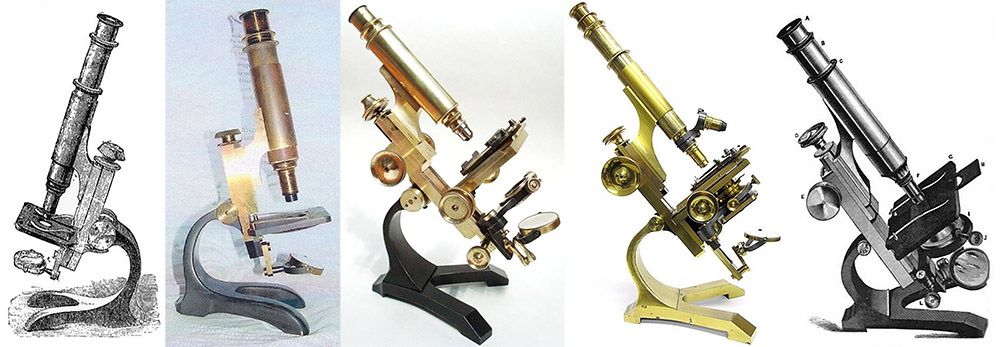
Figure 12.
Moritz Pillischer introduced the unique “Kosmos” in 1887 (left two images). Modified versions were produced over the next several decades. The engraving at the right is from a 1905 announcement of the “New Model Kosmos”. Images of surviving microscopes are adapted for nonprofit, educational purposes from internet sale sites, or by permission from http://www.antique-microscopes.com/photos/Pillischer_Kosmos_microscope.htm.
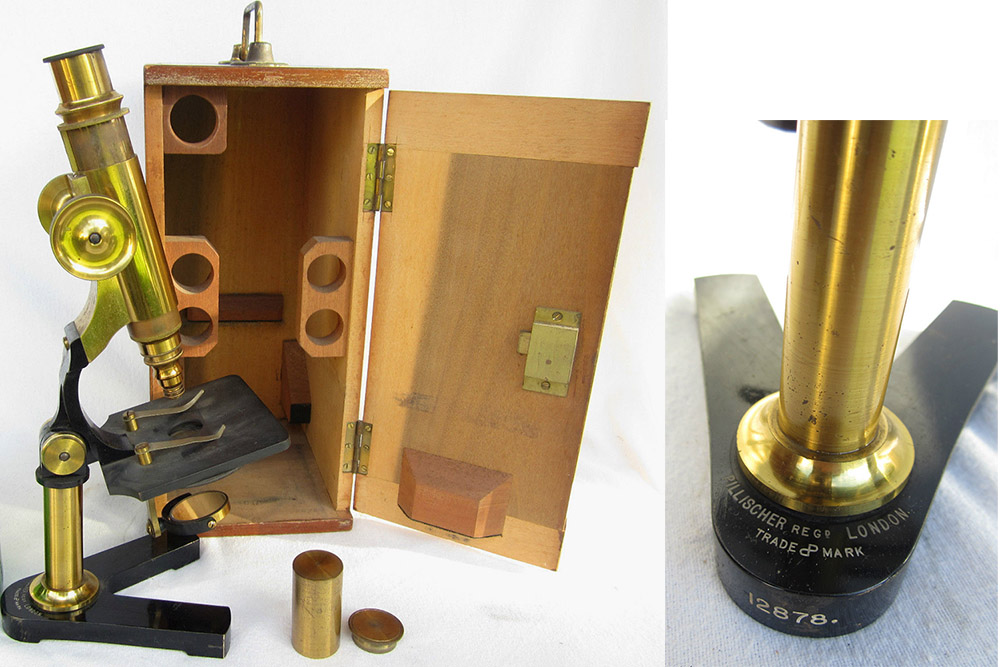
Figure 13.
A twentieth century microscope. Note Jacob Pillischer’s monogram trademark. Adapted for nonprofit, educational purposes from an internet sale site.
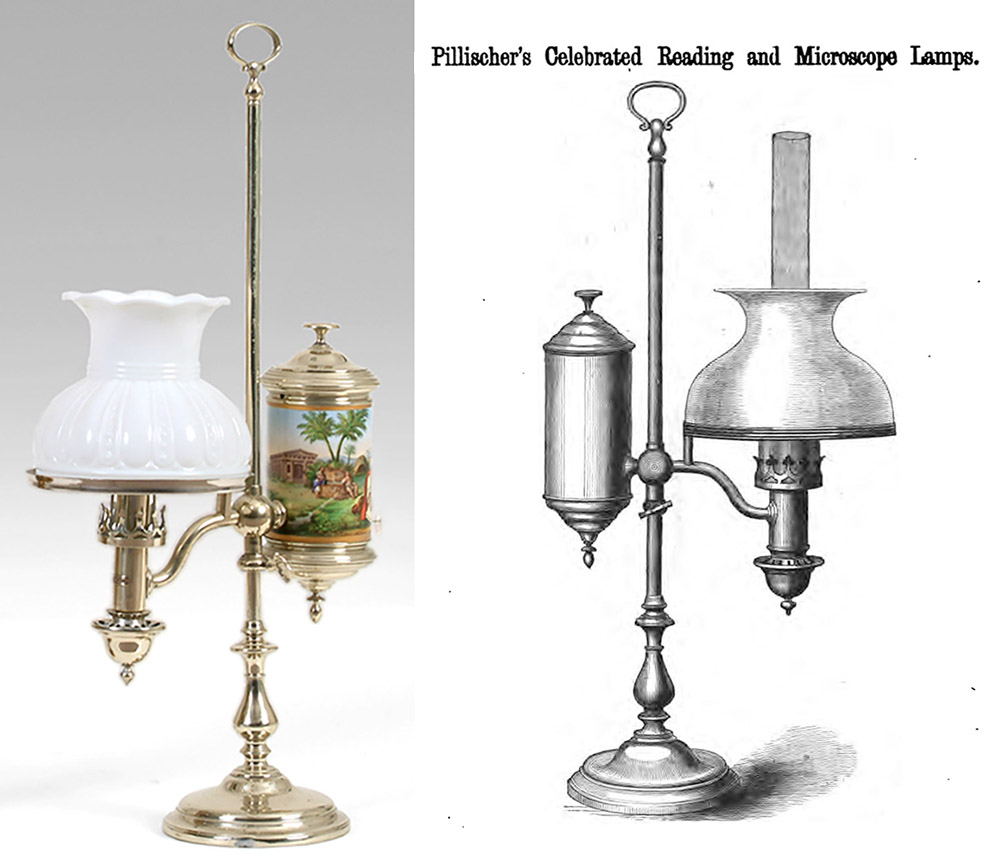
Figure 14.
Circa 1873 Pillischer lamp for reading and for microscope use. Image at left adapted for nonprofit, educational purposes from an internet auction site. Image at right from Pillischer’s 1873 catalogue.
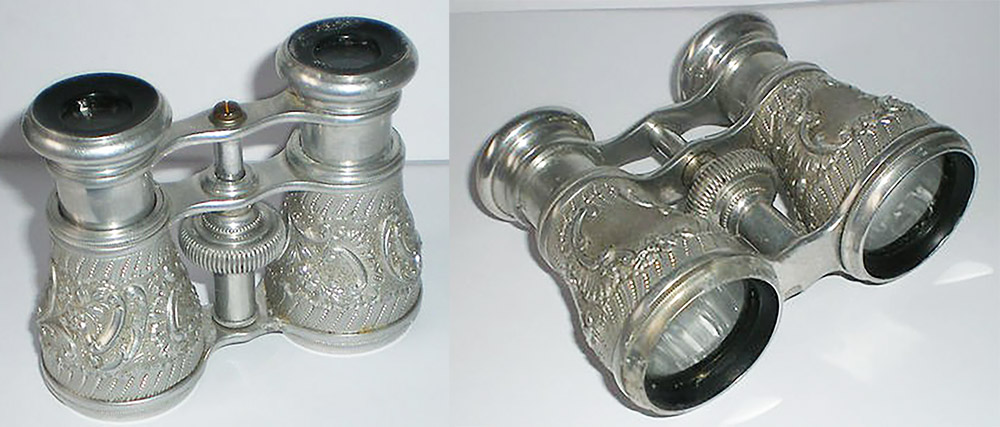
Figure 15.
Pillischer opera glasses with aluminum frames. Adapted for nonprofit, educational purposes from an internet auction site.
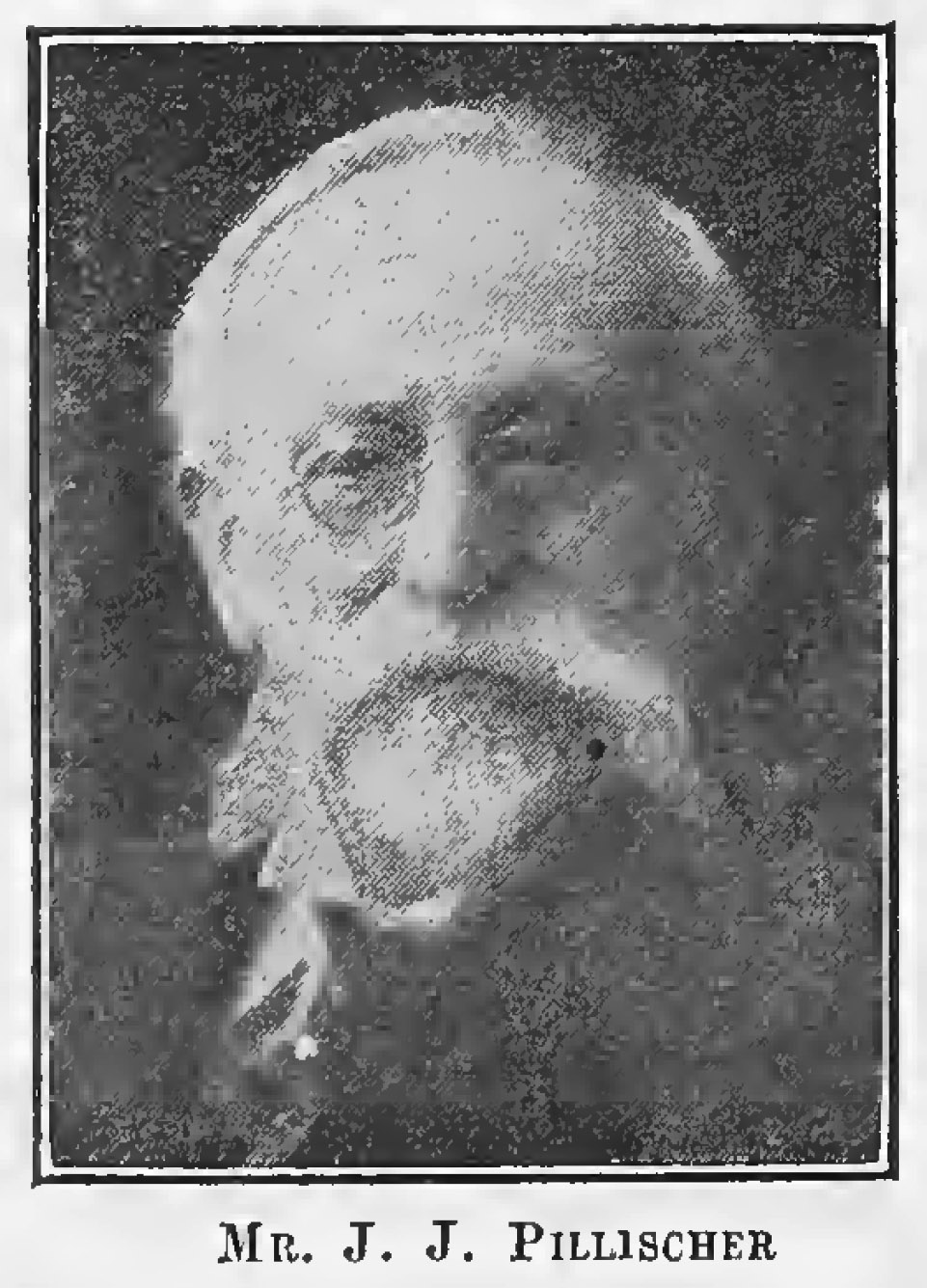
Figure 16.
Jacob “James” Pillischer, near the time of his death (1930). Adapted from an obituary in “Chemist and Druggist”.
Moritz Pillischer was born in Hungary, in approximately 1819 according to the ages he later gave to census takers. Nephew Jacob stated on his naturalization forms that he was born in Óbecse, Hungary, the son of Ignacz and Rosa Pillischer. Since Ignacz was a brother to Moritz’s father, it is reasonable to assume that Moritz was also from that region of Hungary.
Long after his death, it was remarked that Moritz “came to London from Hungary after experience in various continental centres”.
Moritz entered London on October 15, 1845, on a ship from Boulogne. He would then have been about 26 years old. He was recorded as being a “mechanic” (Figure 17). Since Pillischer became an independent manufacturer of microscopes in fewer than 5 years after his arrival, the “experience” noted above presumably included an apprenticeship in working with shaping machines.
Moritz Pillischer married Babete Cohen on February 10, 1847, in the Great Synagogue of London. From their marriage record we learn that his father’s name was Jacob, who was deceased at that time. Moritz’s occupation was listed as “machinist”. He lived at 30 Princes Street, Leicester Square, London. Pillischer was not listed as tradesman/business owner in the 1848 London Directory, so he presumably worked for another person. His employer’s identity is not obvious from the address.
The Pillischer’s first child, Debora, was born on December 16, 1848. Moritz’s occupation was then listed as “optician”, suggesting that he was involved with manufacturing microscopes and/or other optical instruments by that time. The family then lived at 30 Southampton Street, St. Paul, Covent Garden. That address is about 100 meters (100 yards) and a 1 minute walk from 181 Strand, the location of William Cary’s microscope and optical factory/shop. This raises the possibility that Moritz Pillischer worked for Cary as a machinist of the brass used in their microscopes, learning about the trade and perhaps also learning how to grind glasses (noting that he was first a machinist, then an optician). At that time, the Cary shop was owned by William Cary’s two nephews, and managed by Charles Gould (famous for the small case-mounted microscope that he invented). Charles Gould died in 1849, probably succeeded as manager by his relative Henry Gould.
John Quekett’s 1852 edition of A Practical Treatise on the Use of the Microscope stated that “Mr. Pillischer has been a manufacturer of microscopes in this metropolis for the last four years”, consistent with him starting to make microscopes in about 1848. Quekett’s comment need not imply that Pillischer was then an independent manufacturer.
Moritz took a trip to the Continent and returned in January, 1849. His entry record listed his occupation as “optician” (Figure 17). The Pillischer’s second child, Julia, was born in mid-1849. The family’s home at that time was within a 10 minute walk from the Cary shop.
At some time between Julia’s birth and early 1851, the Pillischer family moved a considerable distance away, to 419 Oxford Street. Here, Moritz set up an independent microscope factory and retail shop. According to Quekett, Pillischer did not make his own lenses until 1854, but instead provided French-made objectives with his instruments. This is consistent with records of Pillischer initially being a machinist. A keen understanding of metalwork probably helped Moritz to invent his novel forms of microscopes.
By March of 1851, the Pillischers had either moved a short distance, or the road had been renumbered, to 398 Oxford Street (also listed as 398 1/2 Oxford Street). The 1851 census implies a moderately upper-middle class household that included a domestic servant. That woman may have been a wet-nurse for 3 month-old daughter Rose.
Pillischer entered a broad display of wares in the 1851 London Exhibition, which ran from May 1 until October 15. The Official Descriptive and Illustrated Catalogue stated, “Pillischer, Morrice (sic), 398 Oxford Street - Designer and Manufacturer. Large and small achromatic microscopes, with the stage movements simplified. Students' microscope, capable of forming a portable dissecting, as well as clinical microscope, with all the necessary apparatus. Double achromatic opera-glass. Opera-glasses, mounted in tortoiseshell and gilt, and mounted in ivory. Newly invented compasses, for describing ellipses of any size. Six's thermometer in ivory, for registering maximum and minimum temperatures”. The Jury reported that “Pillischer … exhibits a large microscope stand, which is good for its price, but unnecessarily large and inconvenient for use. He also exhibits two small microscopes”.
Quekett’s 1852 edition of A Practical Treatise on the Use of the Microscope described Pillischer’s instruments, “Mr. Pillischer has been a manufacturer of microscopes in this metropolis for the last four years; he supplies three kinds of stands. The first and most complete of these is represented by (Figures 2, 3, 4, and 18); it consists of a firm tripod of brass, similar to that of Mr. Ross; to this are fixed the two curved supports of a stout plate, capable of being turned on two trunnions. This plate forms the under surface of the stage, and to it is firmly fixed the bent arm, supporting the compound body, which last slides in a dove-tailed groove, after the plan of Mr. Jackson, and is moved up and down by rack and pinion. There is a drawtube in the compound body, immediately below the eyepiece; the coarse adjustment is made by two large milled heads; the fine, by a screw acting on the end of a lever, a plan first adopted by Mr. Ross. The stage is on Turrell's plan, but by a contrivance of Mr. Pillischer's, it is considerably reduced in thickness; the two rectangular movements being effected by turning the milled heads, the latter having a corresponding milled head on the opposite side of the stage. The mirror is of the usual construction, and slides up and down a tube attached to the under surface of the stage-plate”.
“A second microscope for students has a foot and uprights, the same as the larger microscopes; the support for the compound body is a bent arm, to which is attached a tube, about four inches in length, through which the compound body is moved by a rack and pinion, but the rack is not exposed. There is no fine adjustment; the stage consists of the usual sliding-plate, which may be moved up and down by the fingers, or by a lever, after the author's plan; the under surface of the stage is supplied with a diaphragm”.
“Another microscope, made by Mr. Pillischer, is contained in a box seven inches long, by four inches broad, and two-and-a-half inches deep; this box forms the foot, and into the cover screws a tube, three quarters of an inch in diameter and six inches in length, having another tube sliding within it capable of being moved up and down slowly by means of a fine screw; to this tube is attached a strong arm, to which the compound body, six inches in length, is screwed; the compound body is also composed of two tubes, and before being used, the inner one is drawn out two inches, to make it the usual length. The stage is of an oblong square figure, and one of its edges is furnished with a tongue-piece to slip into a slot attached to a short piece of tube which slides up and down the main stem, and so forms the coarse adjustment. The mirror is situated at the bottom of the stem, and is mounted in the usual manner. This instrument will answer for all the purposes for which an ordinary microscope can be used, either in the inclined or vertical position, the inclination being given by opening the cover and keeping it in one place, by means of two long hooks. The low price and portability of this instrument are its principal recommendations”.
“Although the microscope stands of Mr. Pillischer do not differ very materially in external form from those previously described, yet, from being very simple in their construction, he is enabled to furnish them at a rather cheaper rate than those manufactured by the more celebrated opticians. The author, however, from what he has seen, can speak well of the manner in which the work is executed, and thinks that of the microscopes manufactured in this metropolis, the stands of Mr. Pillischer are next in point of merit to those of Messrs. Powell, Ross, and Smith”.
Pillischer began producing a novel, simple microscope soon afterward. His “lenticular” microscope was first described in Golding Bird’s 1853 book, Urinary Deposits, and Pillischer began advertising it at the same time (Figures 7 and 19). The Medical Times and Gazette wrote in January, 1853, “The Simple Microscope is a most useful adjunct to the compound. It may of course be obtained achromatic, but, for ordinary purposes, a good Coddington lens is sufficient. A mechanical adaptation of this lens has lately been constructed by Mr. Pillischer, which every medical man should possess. It is so satisfactory for common diagnostic purposes, that I think a special notice of it is only due to its inventor. It is so simple, compact, and small, that it may be carried about as easily as a snuff-box - in fact, it is not larger than an ordinary snuff-box. It consists of a stage a little larger than the common slides used for stage-glasses, in connexion with which are two springs, which press against the stageglass and keep it firm; an adjustment moving like the fine adjustment, and operating solely on the lens; a mirror and a diaphragm attached to the stage. You can see epithelium with this instrument distinctly; it will therefore be sufficient for most ordinary purposes. It can be obtained for 32s. from Mr. Pillischer, with three Coddington lenses. It is called ‘Pillischer's lenticular’, - a name, I believe, suggested by Dr. Golding Bird”. Four versions of the lenticular microscope were produced, successively introducing a substage wheel of stops and improved mechanisms to hold the glass slide in place. A detailed analysis of this instrument and its forms can be read at http://www.microscope-antiques.com/pilllentic.html.
Bird also recommended Pillischer as good source for an inexpensive, quality microscope, selling for half to two-thirds the price of comparable instruments made by other manufacturers, “I think one of the most economical microscopes I have seen, was made by a German artist lately settled in London (Pillischer, 398 1/2, Oxford Street), its price was five pounds, and it was furnished with an excellent quarter inch achromatic object-glass, and all other really essential pieces of apparatus”.
The Pillischer shop moved during the summer of 1853, to 88 Bond Street (Figure 19). This new site occupied two floors, the sale room on the main floor and a “club room” above, where customers could evaluate Pillischer’s apparatus and slides in comfort. The shop played a supporting role in Kingsley’s 1857 novel, Two Years Ago:
(the protagonist) “paces up still noisy Piccadilly, and then up silent Bond Street; pauses to look at some strange fish on Groves’s counter - anything to while away the time; then he plods on toward the top of the street, and turns into Mr. Pillischer's shop, and upstairs to the microscopic club-room. There, at least, he can forget himself for an hour”.
“He looks round the neat pleasant little place, with its cases of curiosities, and its exquisite photographs, and bright brass instruments; its glass vases stocked with delicate water-plants and animalcules, with the sunlight gleaming through the green and purple seaweed fronds, while the air is fresh and fragrant with the seaweed scent; a quiet, cool little hermitage of science amid that great, noisy, luxurious west-end world. At least, it brings back to him the thought of the summer sea, and Aberalva, and his shore-studies: but he cannot think of that any more. It is past; and may God forgive him!”
“At one of the microscopes on the slab opposite him stands a sturdy bearded man, his back toward the major; while the wise little German, hopeless of customers, is leaning over him in his shirt sleeves”.
“ ‘But I never have seen its like; it had just like a painter's easel in its stomach yesterday!’ "
“ ‘Why, it’s an Echinus Larva; a sucking sea urchin! Hang it, if I had known you hadn't seen one, I'd have brought up half a dozen of them!’ " (the protagonist and the bearded man then recognized each other and struck up a conversation, leaving Moritz Pillischer to hope for other customers)
The microscope with serial number 167 bears the 398 Oxford Street address, while serial number 182 lacks an address, and presumably was produced at the 88 New Bond Street shop. This suggests that microscopes with serial numbers ca. 170-180 date from before 1853, and higher numbers after that date.
Pillischer released a new version of his “Student” microscope in late 1854 (Figure 8). Quekett described it in his 1855, third edition of A Practical Treatise on the Use of the Microscope, “The foot and the uprights are similar to those of the instruments of Mr. Ross and Mr. Ladd, but all the other parts of the microscope are different. A stout square tube has two smaller square tubes sliding within it; one of these is moved up and down by rack and pinion, forming the coarse adjustment; the other being slowly raised or depressed by the screw, constituting the fine adjustment. The stout arm carries a short compound body which can be lengthened to the required extent by the draw-tube. The stage is furnished with an object-plate, capable of being moved about in various directions by a short lever. The mirror is a double one and has all the usual movements; it is attached by a short cylinder to the base of the square tube … The student's microscope, last described, is one of the cheapest instruments that has yet been offered to the public; the workmanship quite equals that of his larger stands, and when packed in a mahogany case, and furnished with a one-inch and a one-quarter inch object-glass of Mr. Pillischer's own construction, two eye-pieces, animalcule cage, and forceps, the price does not exceed £9 10s”. The lever-manipulated stage was developed by Cornelius Varley, and is generally known by his name.
The basic form of Pillischer’s 1854 “Student” microscope was used in other models over the next several decades, including the “Saint Thomas Hospital” and “International” models (Figures 10 and 11)
Quekett also noted in 1855 that Pillischer had begun to produce his own lenses, “Mr. Pillischer������������������������������� has lately turned his attention to the manufacture of object-glasses, and is now enabled to furnish them to all his microscopes, and not employ those of French construction, as heretofore. The author has lately had an opportunity of examining a 1/4 having an aperture of 75°, which performed exceedingly well”. This further supports the hypothesis that Pillischer was initially a metalworker.
Pillischer exhibited “microscopes et instruments d’optique” at the 1855 Paris Exposition.� Sir David Brewster wrote, “Mr. Pillischer, of Bond-street, exhibited a microscope with an achromatic object-glass half an inch in focal length and of such excellence that a medal of the Second Class was awarded to him. Mr. Pillischer also exhibited what he calls a lenticular microscope, for examining urinary deposits at the bedside, which has been highly spoken of by the late Dr. Golding Bird and Mr. Quekett. Mr. Pillischer's students' microscopes were remarkable, not only for their cheapness, but the excellence of their construction”.
Moritz Pillischer was elected as a Fellow of the Royal Microscopical Society in 1855. He joined the Quekett Microscopical Club in January, 1869.
Nephew Jacob Pillischer joined the household between 1851 and 1861. He had been born on December 1, 1831 in Óbecse, Hungary, the son of Moritz’s brother, Ignacz, and Rosa Pillischer. The 1861 census listed the 22 year-old as being an “optician’s assistant”. Jacob’s future wife, Moritz’s�� third daughter, Rose, was then 11 years old. The household also included four additional daughters and a son, plus two domestic servants. On that census, and in various records through the future, Jacob adopted the name “James”.
A prize was awarded at the 1862 London Exhibition for one of Pillischer’s inexpensive microscopes, thereafter known as “The £5 Prize Microscope”. His exhibits were described, “M. Pillischer, M. (United Kingdom, 2945), exhibits a considerable variety of microscopes, some of which may fairly claim the denomination of first-class instruments; and the advance of his recent exhibit from that of 1851 evinces much persevering industry. His brass-work is very good; it is generally on the ‘Ross’ model, except that a little curvature is given to the outline of the vertical supports. The optical work is good, but has not yet reached the highest standard of excellence. The object in his collection which was considered most entitled to commendation, was a very compact student's microscope in a neat mahogany case. The objective consisted in a triple achromatic combination; the first, composed of three lenses, made a good objective of one-inch focus. The addition of the second, a correcting combination of two lenses, gave an indifferent half-inch objective; but the addition of the third combination constituted a very effective glass of quarter-inch focus; and the price of the whole, namely £5, does not exceed that of a quarter-inch objective alone, by either of the first makers”.
Jabez Hogg devoted four pages to Pillischer in his 1869 edition of The Microscope. Praise was accorded, “Mr. Pillischer … is favourably known for the excellency of his instruments. His No. 1 Microscope … is of good workmanship, and somewhat novel in design”, “a compound microscope, made by Mr. Pillischer for the use of students. In every respect it is a compact, handy instrument, and well finished in its mechanical details”, and “The instrument … Mr. Pillischer designates his £5 Prize Medal Microscope, is an excellent student's instrument, simple and novel in its construction, and well adapted to almost any description of work. The body is furnished with a draw-tube and fine adjustment; the arm which supports this derives additional steadiness from the square solid form given to the box in which the rack and pinion move. A convenient and simple lever-stage, with a double joint, enables the right hand to move the object in any direction with great facility. This can be readily detached when it is desired to clear the stage for a frogplate, &c. The instrument is furnished with a dividing set of powers, working with a tolerably flat-field; diaphragm, condenser for opaque objects, live box, &c The whole packs in a neat case, measuring only 8x6 inches; forming one of the most portable microscopes for the use of the student we have seen”.
Moritz’s wife, Babete, died on March 12, 1870, at the age of 47. She appears to have died from a ruptured appendix. The next year’s census showed Moritz, four daughters, and a servant all living at 88 Bond Street. Jacob lived alone in a house on Haddon Street, described as “manager to optician”. On July 17, 1872, Jacob and Rose were married, at the Pillischer home/shop on Bond Street.
Heinrich Frey wrote in his 1872 The Microscope and Microscopical Technology, “The three most renowned London firms are: Powell & Lealand (170 Euston road), Andrew Ross (7 Wigmore street, Cavendish square, W.), continued, since the death of the founder, by the son, Thomas Ross, and Smith, Beck & Beck (6 Coleman street). Among the remainder we will also mention Pillischer (2 [sic] New Bond street), W. Highley (70 Dean, street, Soho square 10), and Baker (44 High Holborn). It is highly commendable that, for a series of years, the English have endeavored to produce instruments which might be as cheap as possible and, at the same time, good. Thus, for example, a number of establishments furnish very fine instruments even for £5, as Pillischer, Smith, Beck & Beck”. Frey’s book also included a current price list from Pillischer (Figure 24).
Another prize was awarded at the 1873 Vienna Exhibition, where “Mr. Pillischer has, among other articles of interest, a standard thermometer and a barometrograph, which daily records the variations of atmospheric pressure”.
The Lancet reported, “We are pleased to learn that Mr. M. Pillischer, the well-known optician and microscope maker, of New Bond-street, has been decorated by the Emperor of Austria with the golden cross and crown of merit as a mark of His Majesty’s high approval of the very beautiful display of scientific instruments at the late Exhibition”.
By 1881, Moritz had moved to Hove, Sussex, although he retained ownership of the Pillischer optical business. The 1881 census shows him living with three unmarried daughters, and two house servants. Jacob also lived away from the New Bond Street shop, at 19 Acacia Road, Marylebone, with Rose, their three children, and two servants.
Ownership of the Pillischer business officially transferred from Moritz to Jacob in 1887. This occurred after January 12, when “Mr. M. Pillischer exhibited his new ‘Kosmos’ microscope” at a meeting of the Royal Microscopical Society”. After this time, instruments were often marked ‘Pillischer’, without a first initial.
Jacob exhibited at the 1889 Paris Exhibition under his own name. The Catalogue of the British Section listed, “Pillischer, J., 88 New Bond Street, London, W. Microscopical apparatus and appliances; photographic apparatus; ophthalmic, astronomical, mathematical and other instruments of precision; spectacles and eye-glasses; surveying and meteorological instruments”. He was awarded a Gold Medal.
Moritz Pillischer passed away in his Sussex home on March 4, 1893. He died a fairly wealthy man, leaving an estate of over £40000.
Jacob joined the Quekett Microscopical Club on November 15, 1895, and the Royal Microscopical Society on April 20, 1898.
He brought in several old Pillischer microscopes for display to his RMS colleagues, including a lenticular and an early compound instrument with a Tomes stage (see Figures 3 and 4). Of the latter, the Journal of the Royal Microscopical Society wrote, “This stage was known as the ‘Tomes’ stage. Mr. Charles Tomes (afterwards Sir Charles Tomes, F.R.S., &c, Surgeon Dentist to the Middlesex Hospital) was the inventor and for some years it was very popular with medical men as an inexpensive and handy form of apparatus, especially for dissecting purposes. As far as can be traced it was first made about 1847, and remained popular for about ten years. This Microscope belonged to the late Sir William White-Cooper, Ophthalmic Surgeon to Her late Majesty the Queen, and has now been put in working order for the use of his grandson”. The attribution to Sir Charles is a mistake, as he was born not born until 1846. The stage’s developer was his father, Sir John Tomes (1815-1895), also a famous dental surgeon.
During the early 1900s, Jacob became aware of retailers in Argentina who were selling German clinical thermometers that were illegally marked with Pillischer’s name. He needed to go to South America to settle this issue, but could not because he was not a British citizen and did not have a passport. Acquiring those took him over a year, a major obstacle being his intention of leaving the country as soon as he became a citizen. It is through Jacob’s citizenship paperwork that we learn of his birth date, his parentage, and other life details.
Jacob Pillischer died in 1930, “At 9 Carlton Hill London, N.W.8, on January 8, Mr. James Jacob Pillischer (J. Pillischer, Ltd., scientific instrument manufacturers, 88 New Bond Street, London, W.1), aged ninety-one. The business with which Mr. Pillischer was connected was founded in Oxford Street, W.1, in 1843 by his uncle, Mr. Moritz Pillischer, who came to London from Hungary after experience in various continental centres. Mr. Moritz Pillischer set a very high standard of workmanship for all his optical, surgical and other instruments; and his clientele included members of the British Royal Family and several foreign sovereigns. He is mentioned in Charles Kingsley's ‘Two Years Ago’. Mr. J.J. Pillischer succeeded his uncle as proprietor in 1894." The dates are inaccurate, as described above. Related to that, Jacob’s advertisements generally misstated the Pillischer business’ founding dates (e.g. Figure 30).
The Pillischer business was inherited by Jacob's three children, Edward, Leopold, and Bertha. The business shut down in 1947.
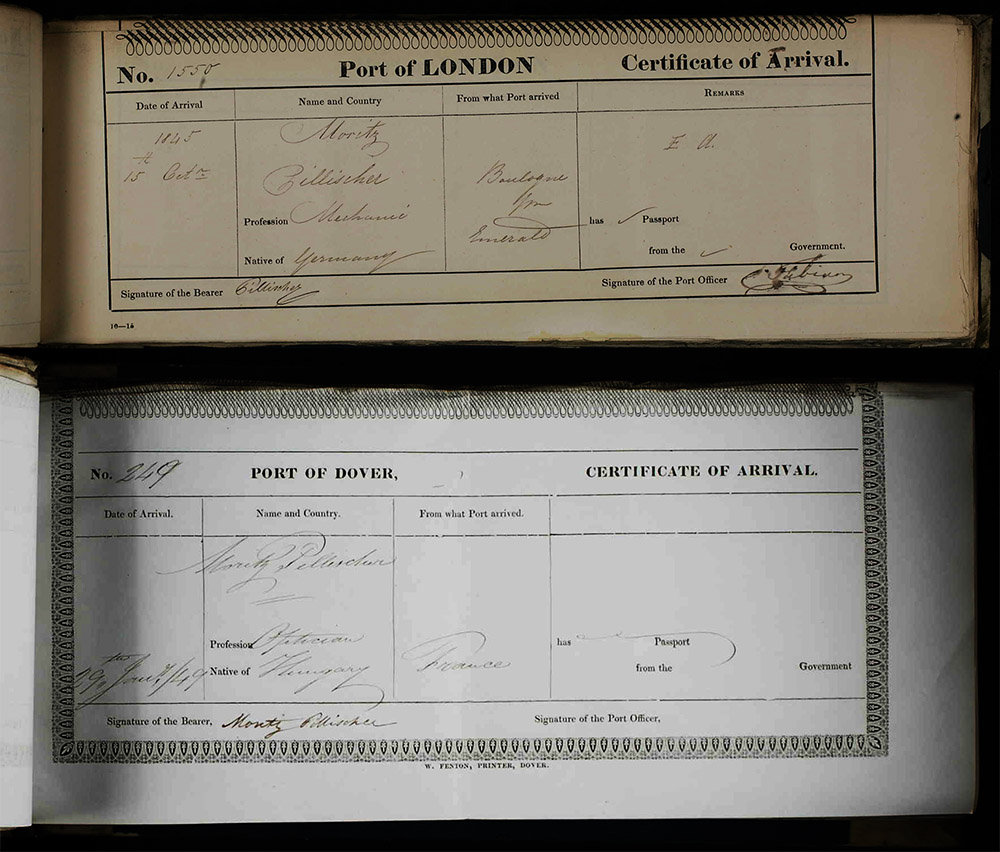
Figure 17.
Records of Moritz Pillischer’s entries into England, from 1845 (top) and 1847 (bottom).
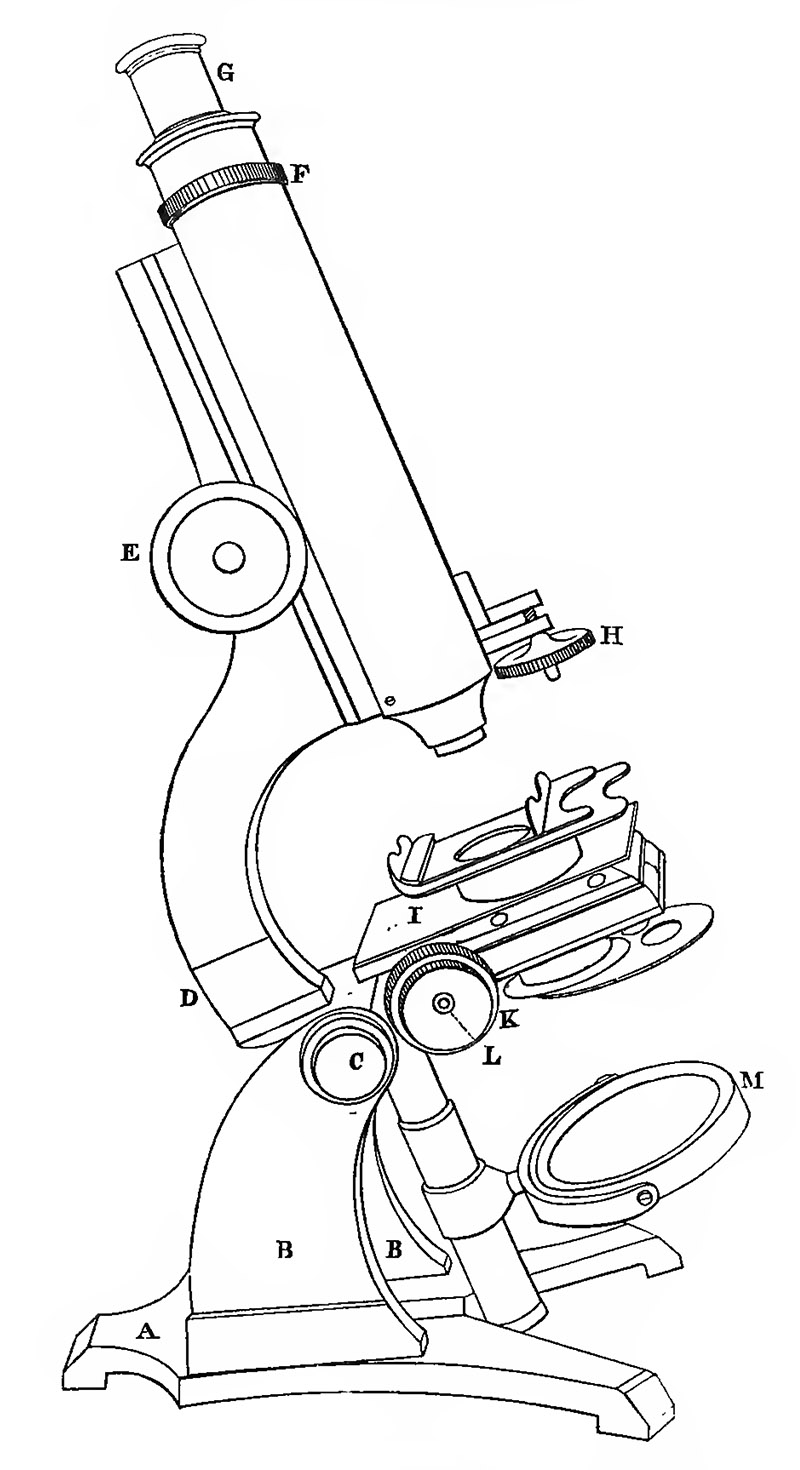
Figure 18.
Pillischer’s “first and most complete” microscope, as illustrated in John Quekett’s 1852, second edition of “A Practical Treatise on the Use of the Microscope”. This is the same model shown in Figures 2-4, above. The illustration indicates a mechanical stage that is operated by a pair of knobs and gearworks.
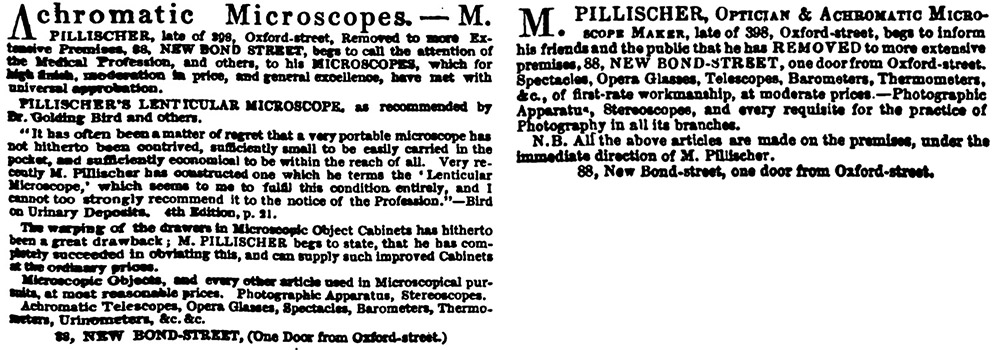
Figure 19.
Advertisements from mid-1853, announcing Pillischer’s move to 88 New Bond Street. Left, “The Lancet”, July issue, which is also one of the first advertisements for Pillischer’s lenticular microscope. Right, “The Art-Journal”, September issue.
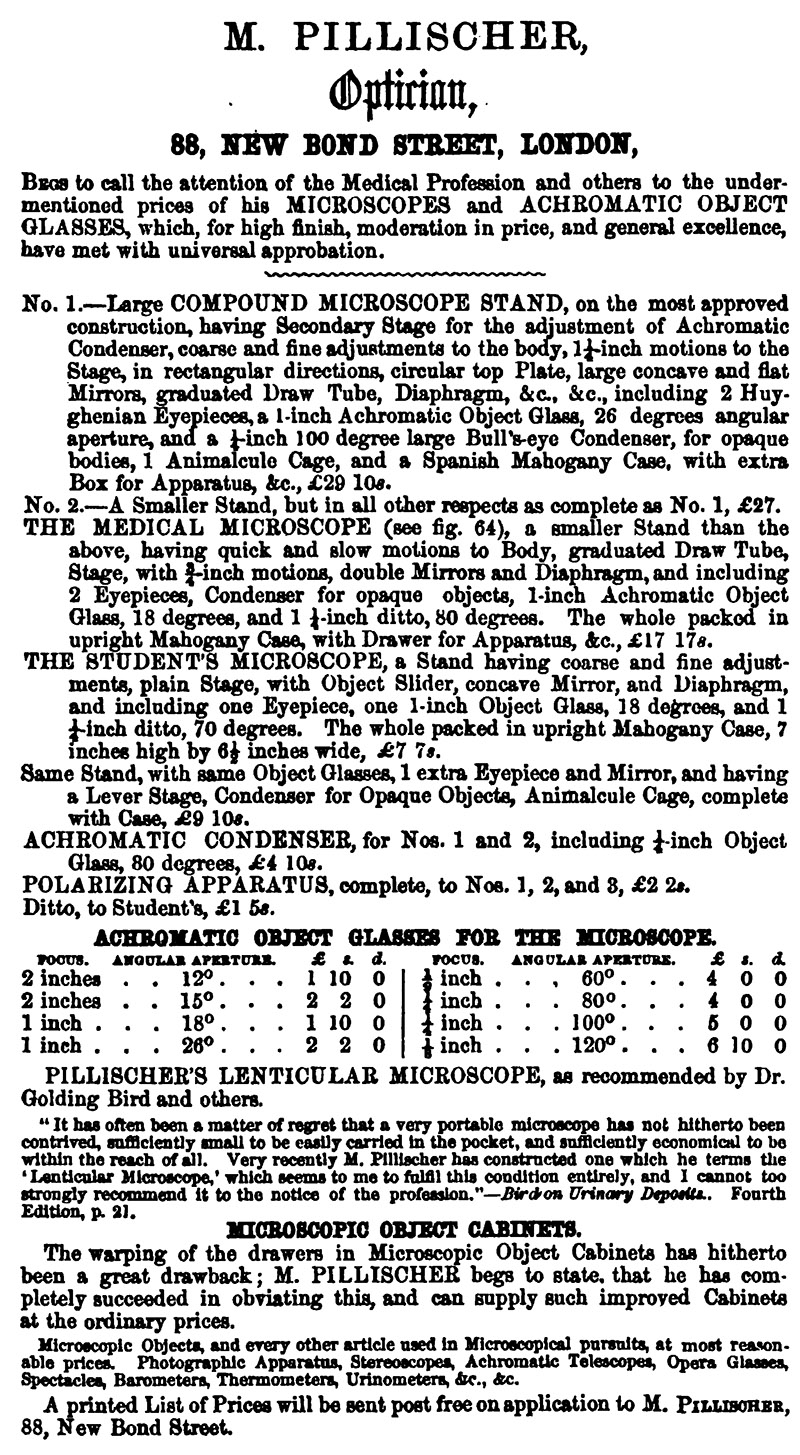
Figure 20.
Advertisement from John Quekett’s 1855, third edition of “A Practical Treatise on the Use of the Microscope”.
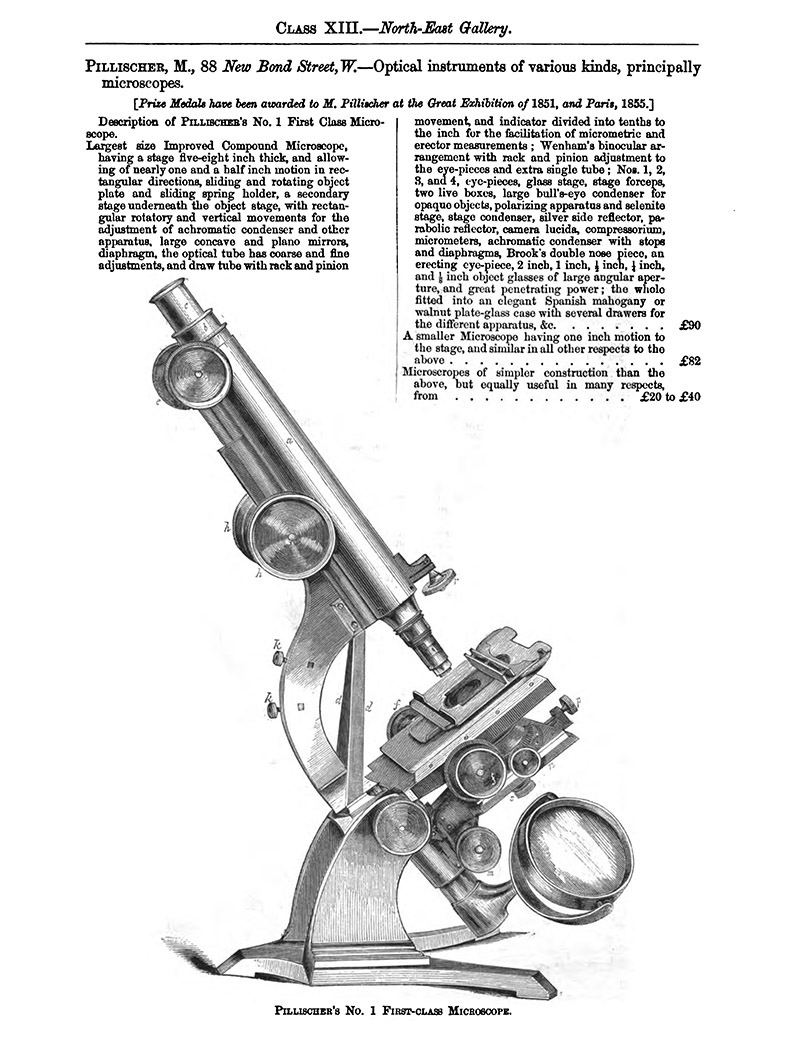
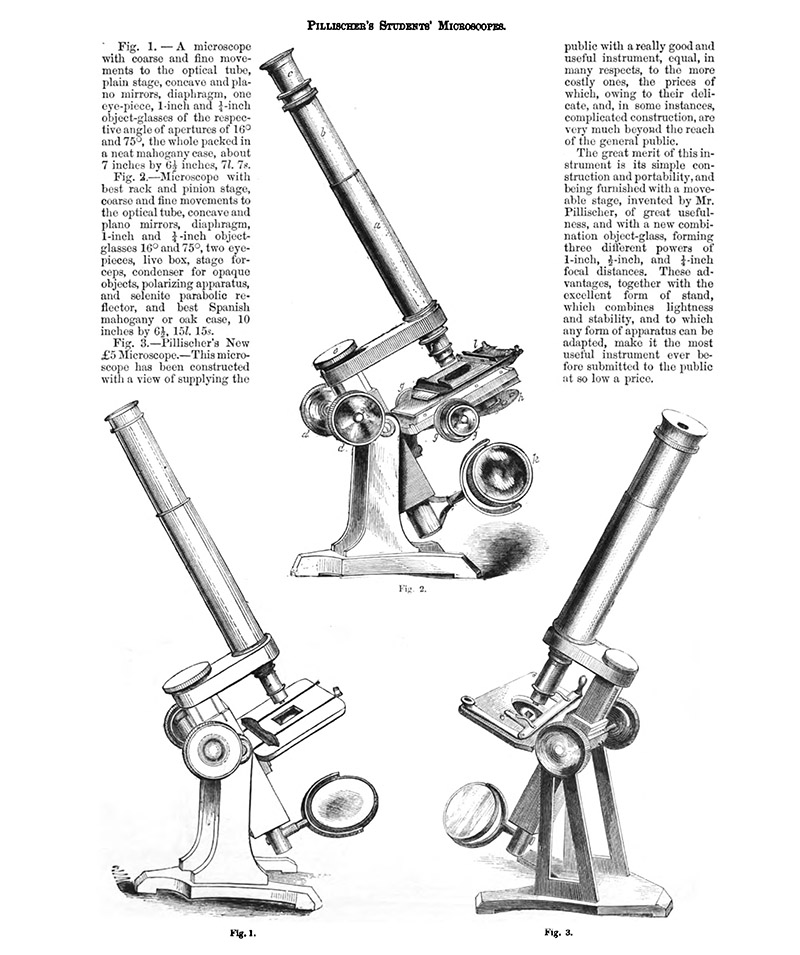
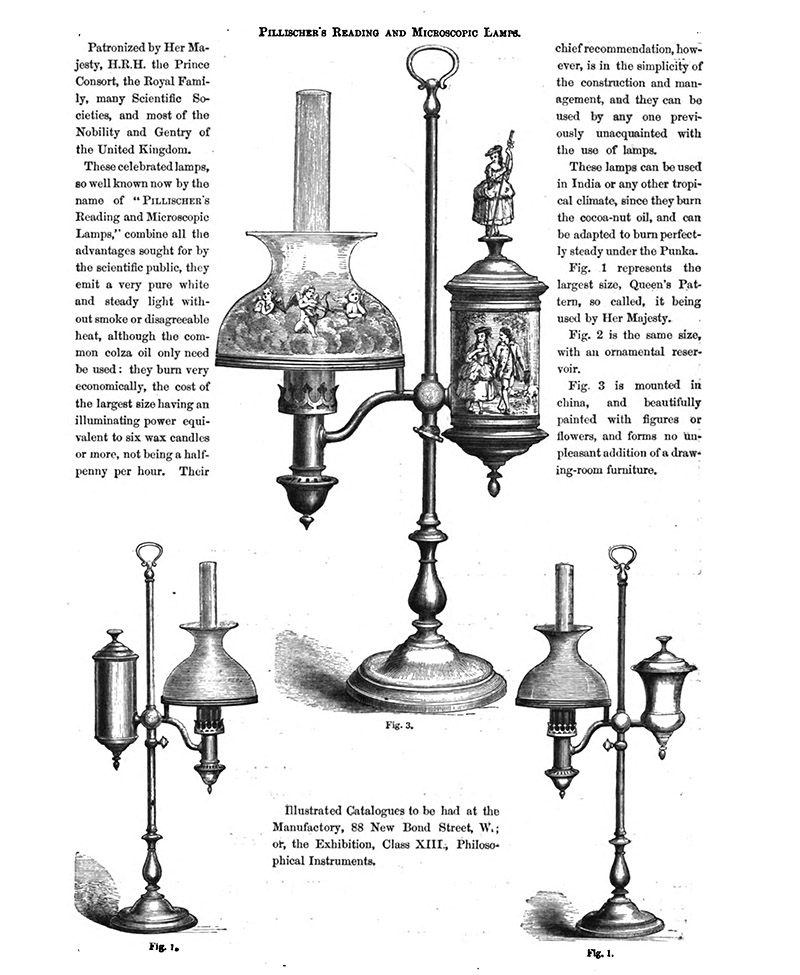
Figure 21.
Illustrations and descriptions of microscopes and other instruments that Pillischer entered into the 1862 London Exhibition
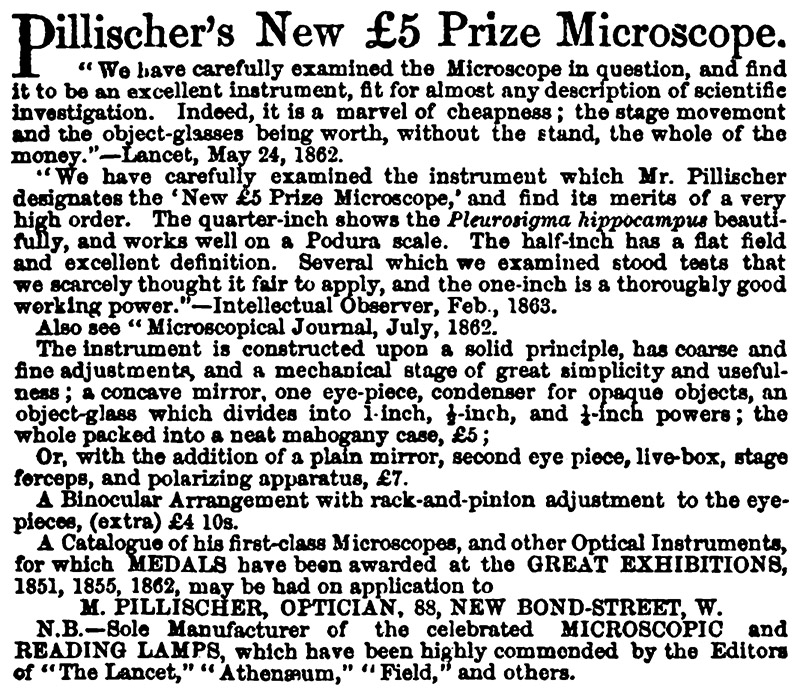
Figure 22.
1862 advertisement from Moritz Pillischer, announcing the prize awarded for his £5 microscope, heretofore renamed the “New £5 Prize Microscope”. From the August 1, 1862, edition of “The Medical Times and Gazette”.
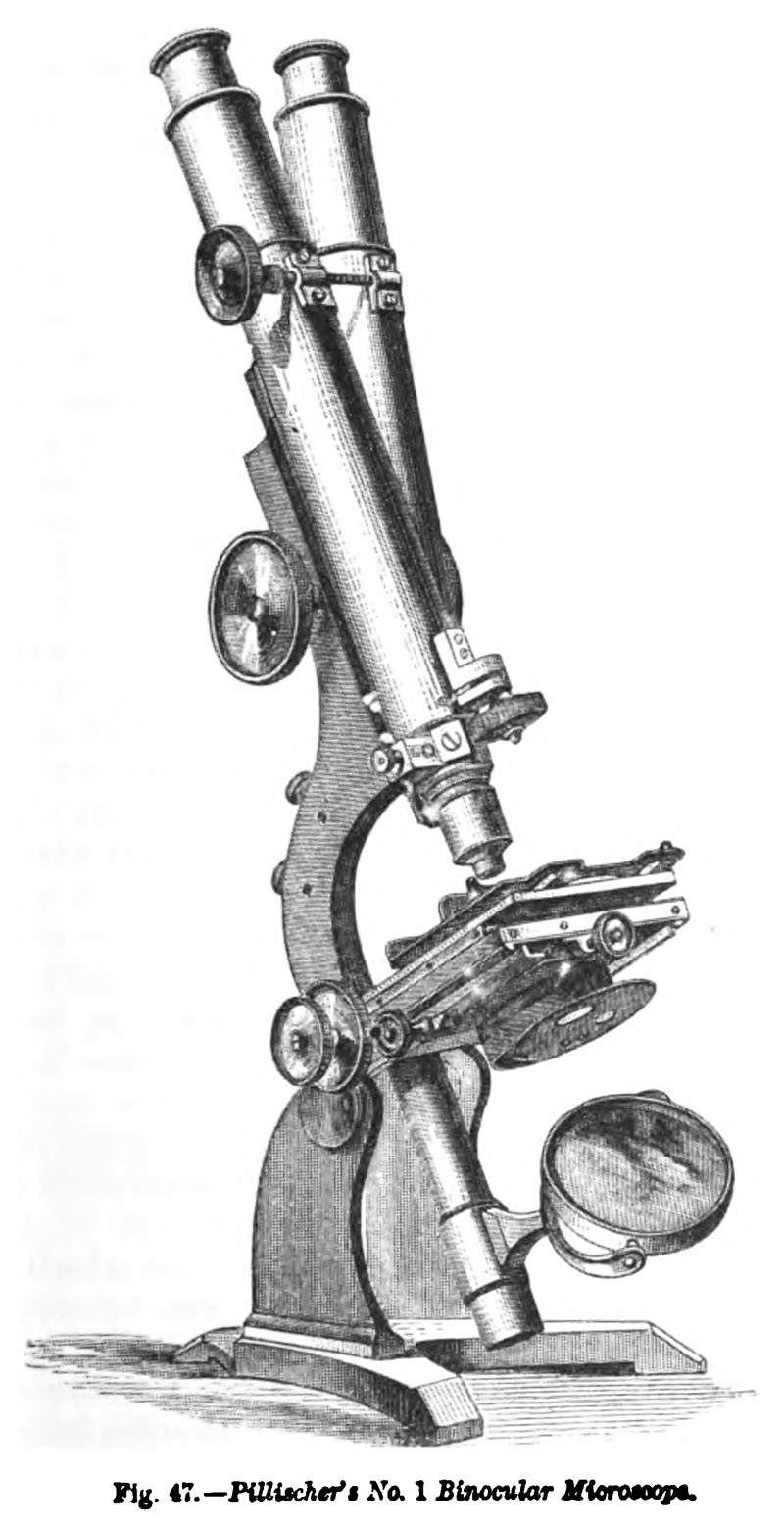
Figure 23.
Pillischer’s Number 1 model microscope in 1869, as illustrated in that year’s edition of Jabez Hogg’s “The Microscope”. That volume also included illustrations of a simpler microscope with rack-and-pinion mechanical stage and the £5 microscope, renamed the “Prize Medal” microscope after the 1862 London Exhibition (see Figures 9 and 22).
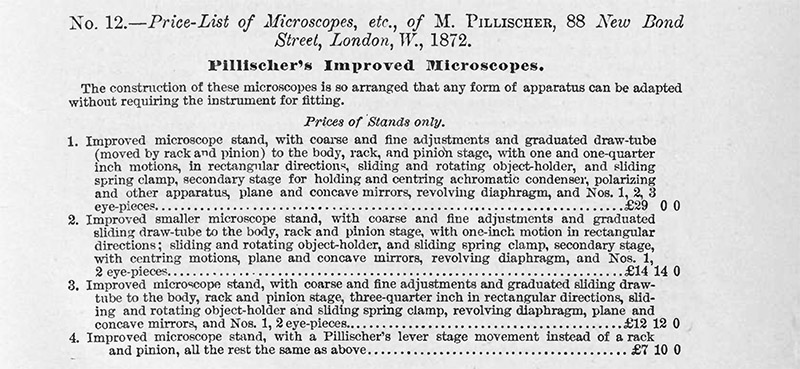
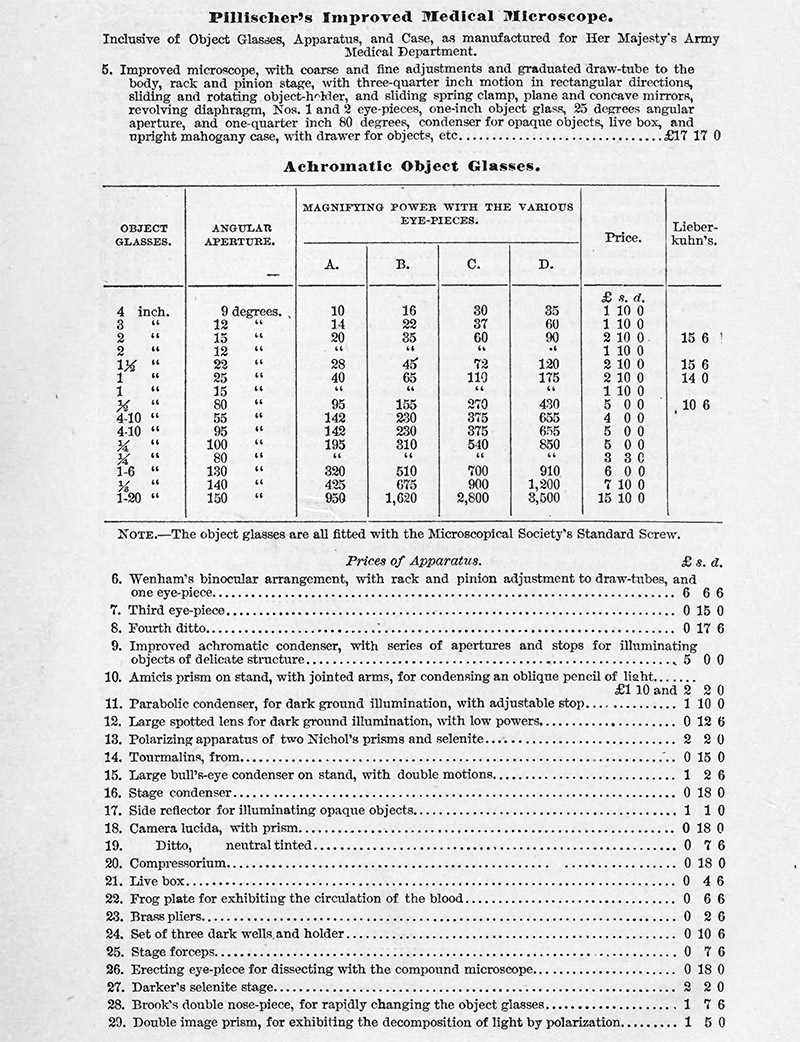

Figure 24.
Pillischer’s ca. 1872 price list, from Heinrich Frey’s “The Microscope and Microscopical Technology”, 1872.
Figure 25 (following). Pages of microscopes from Pillischer’s 1873 catalogue.
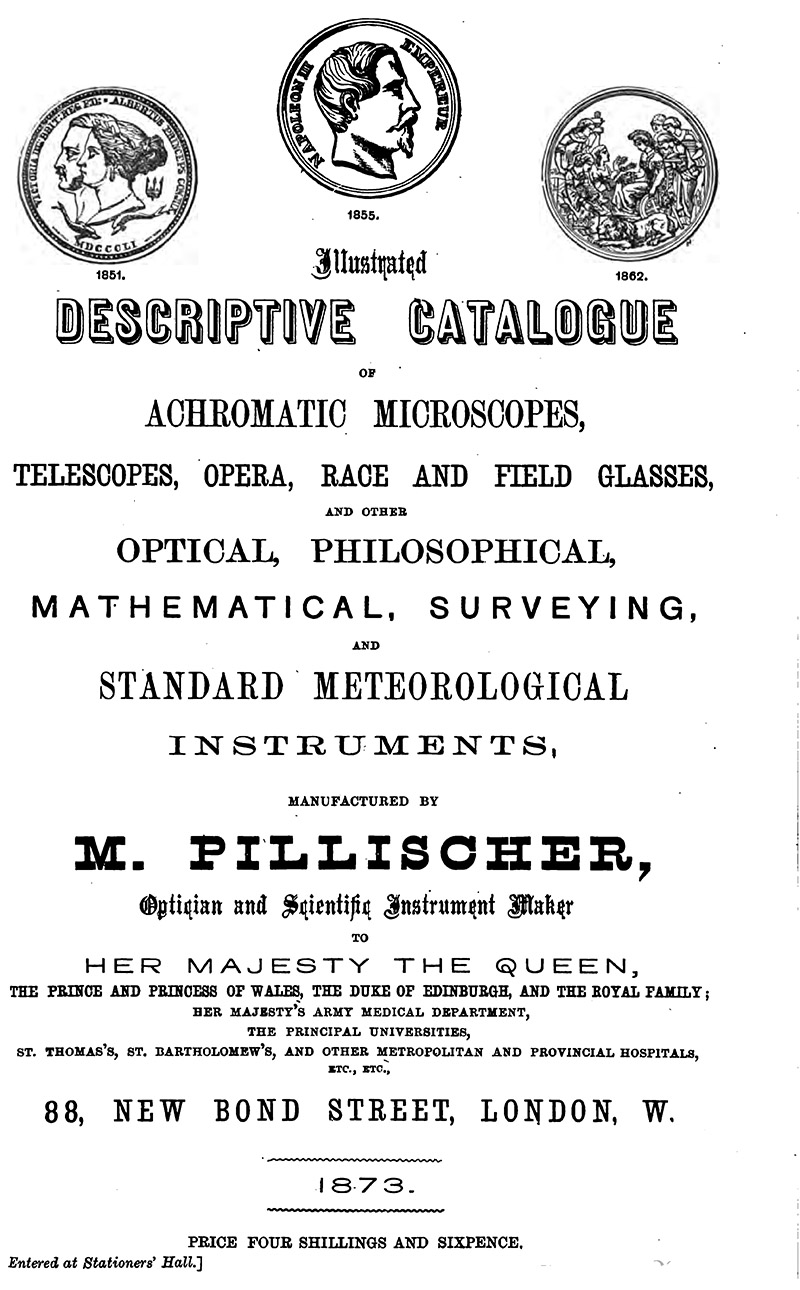
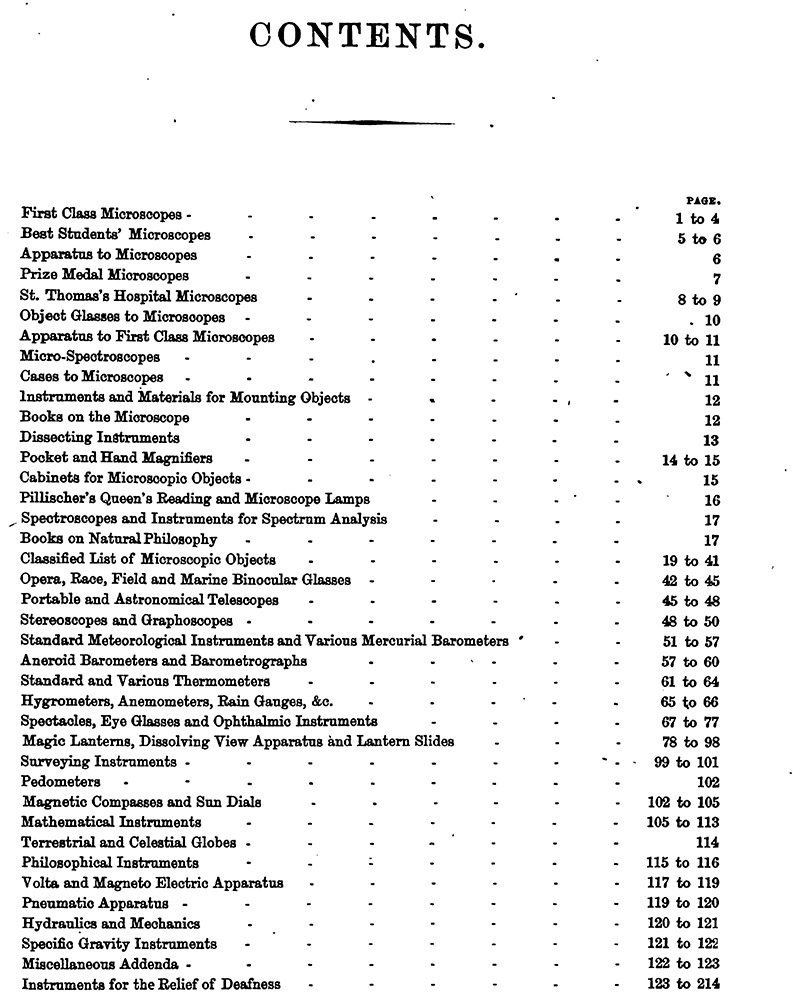
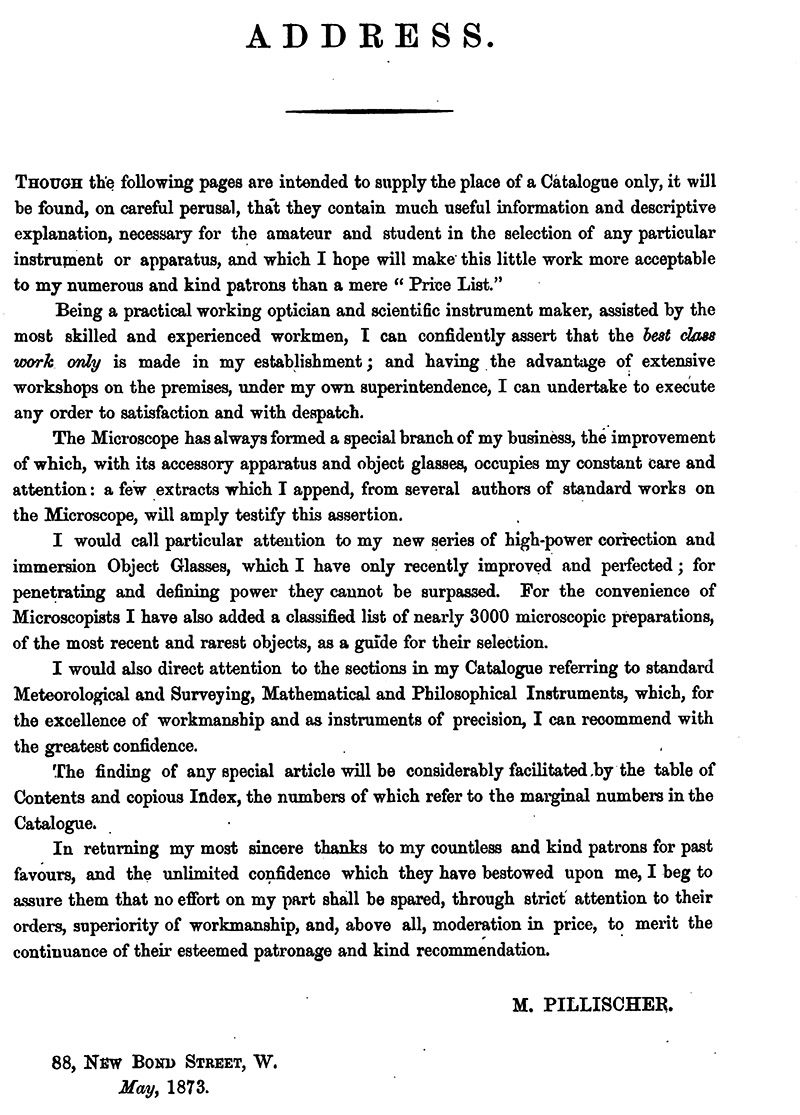
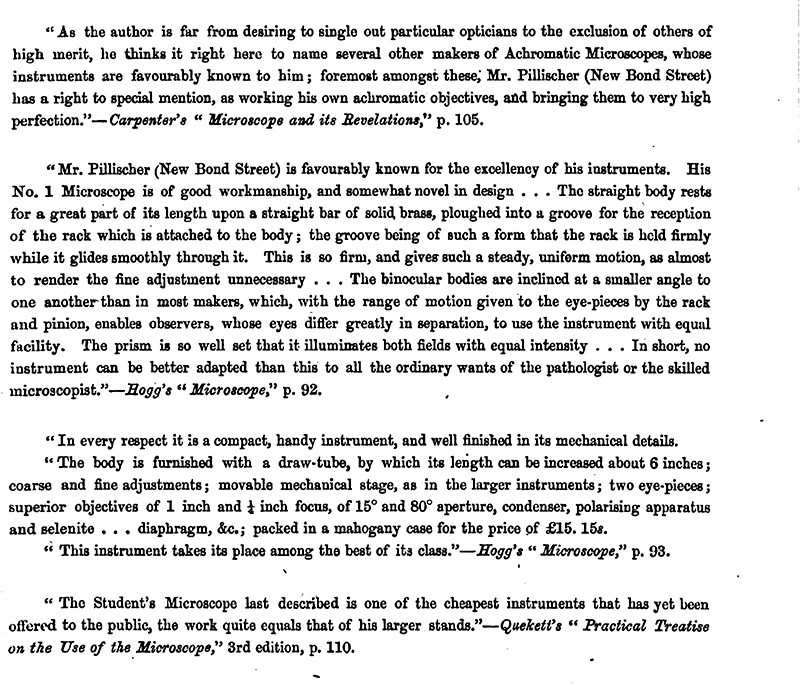
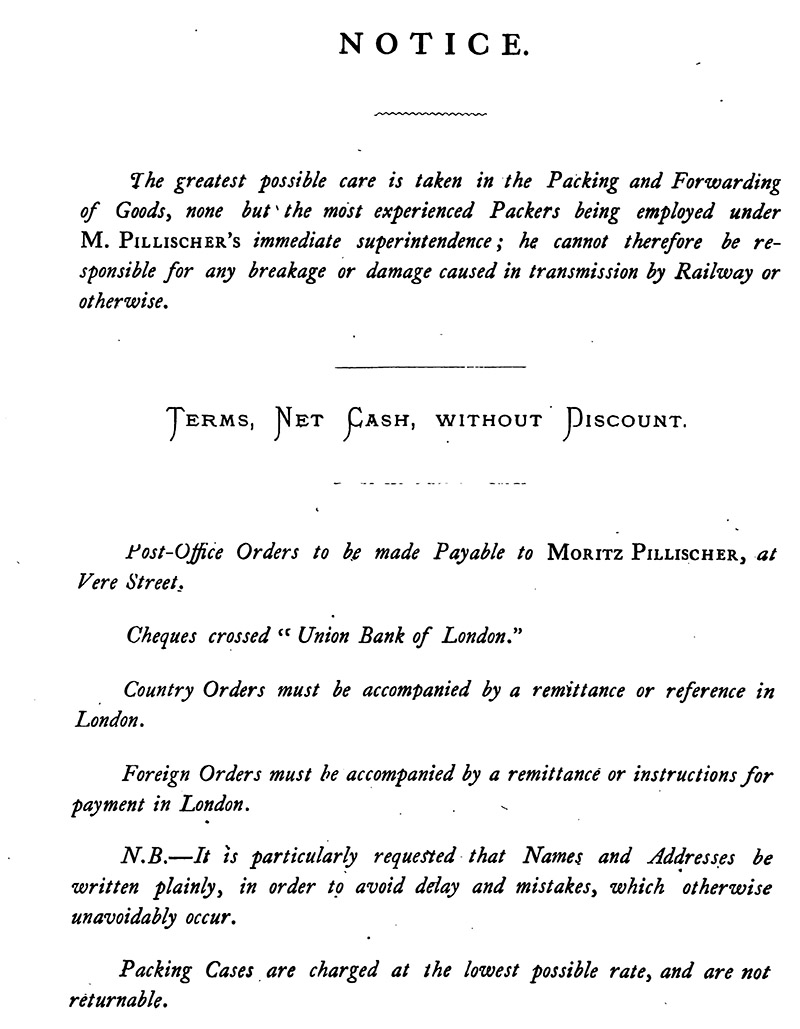
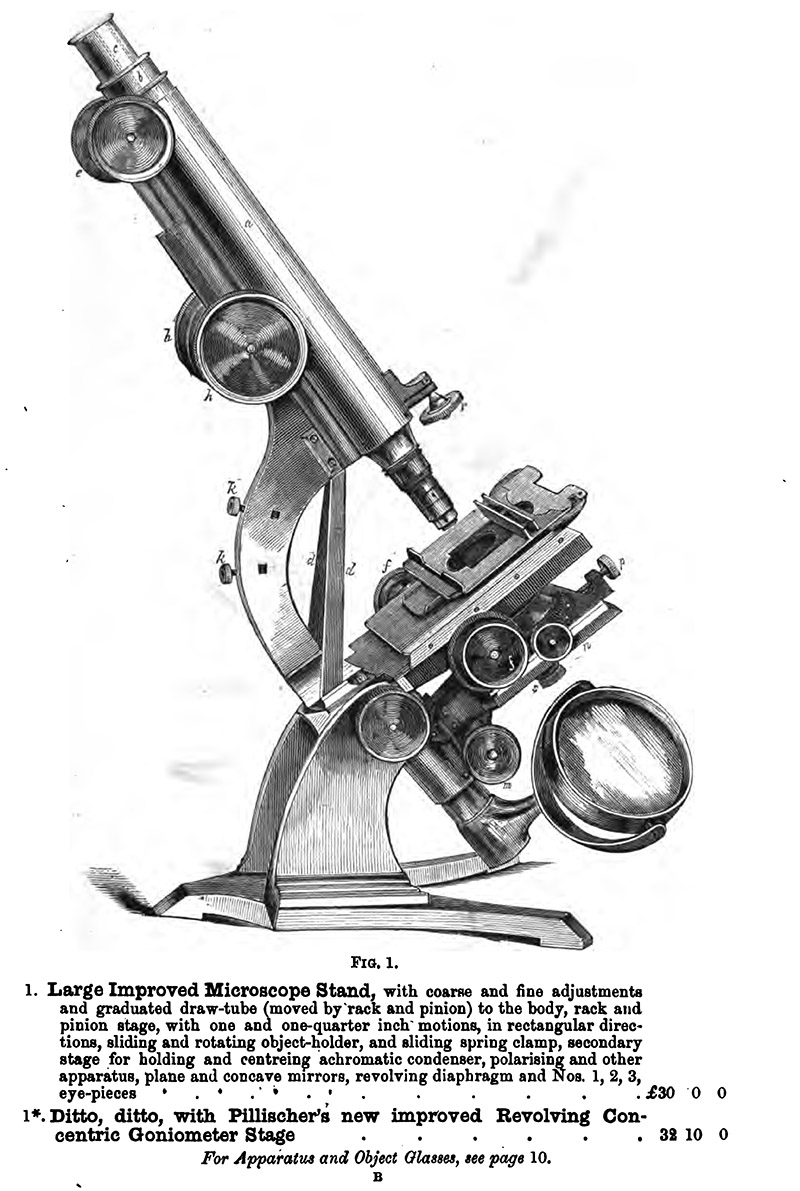
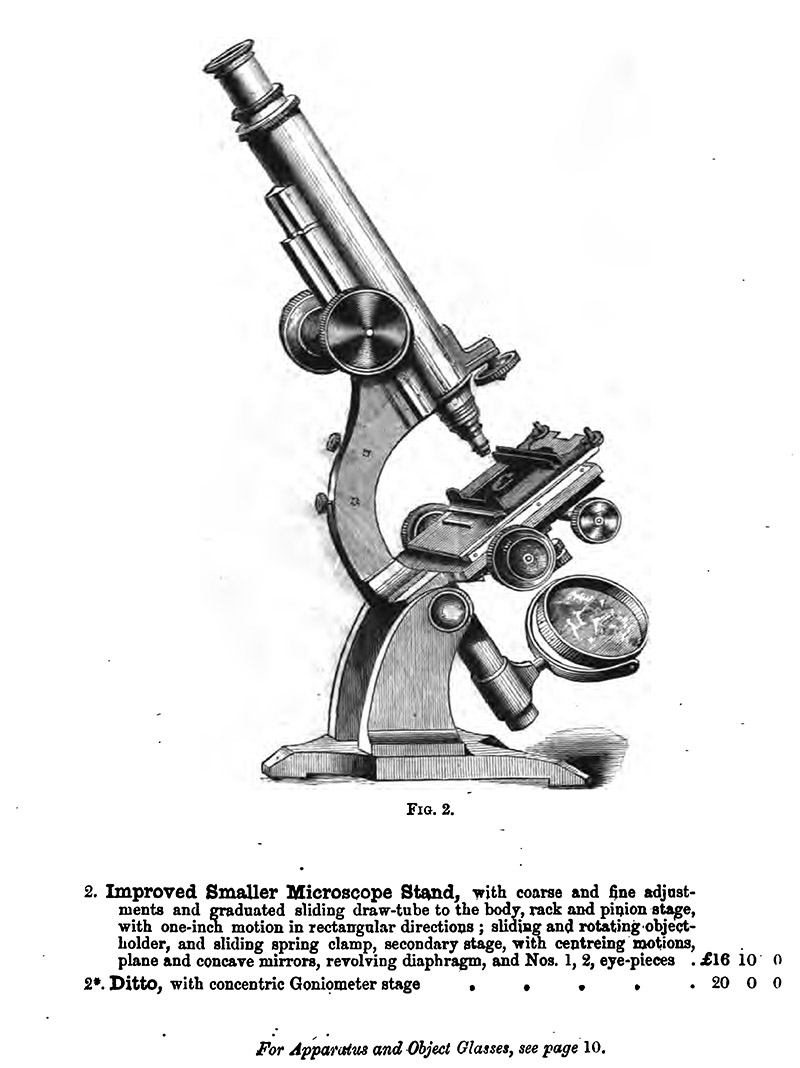
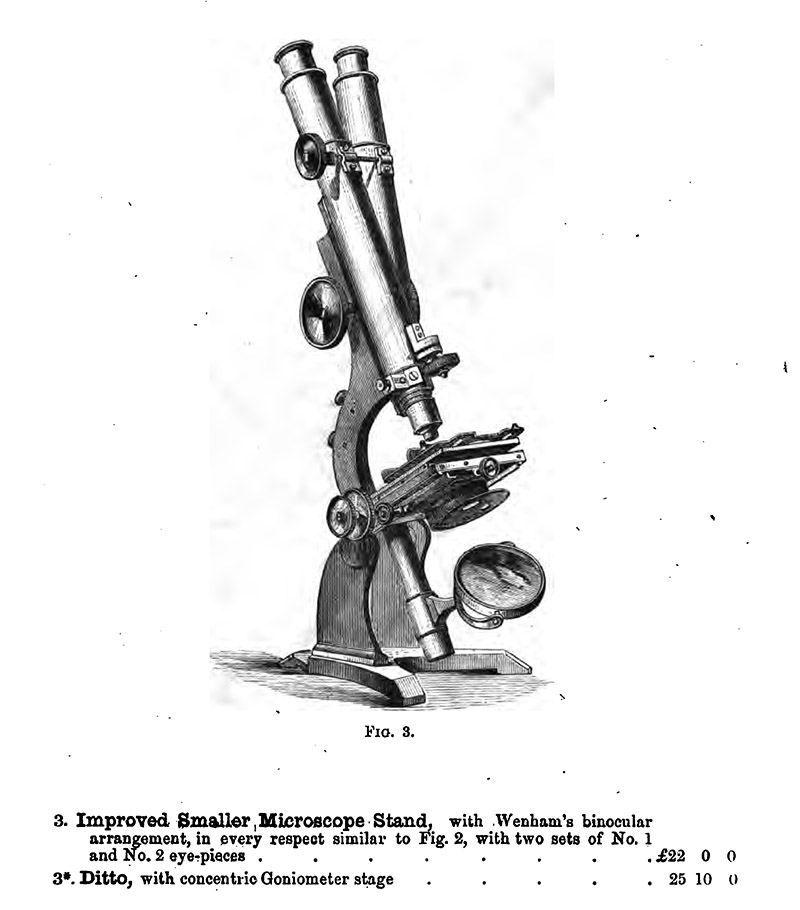
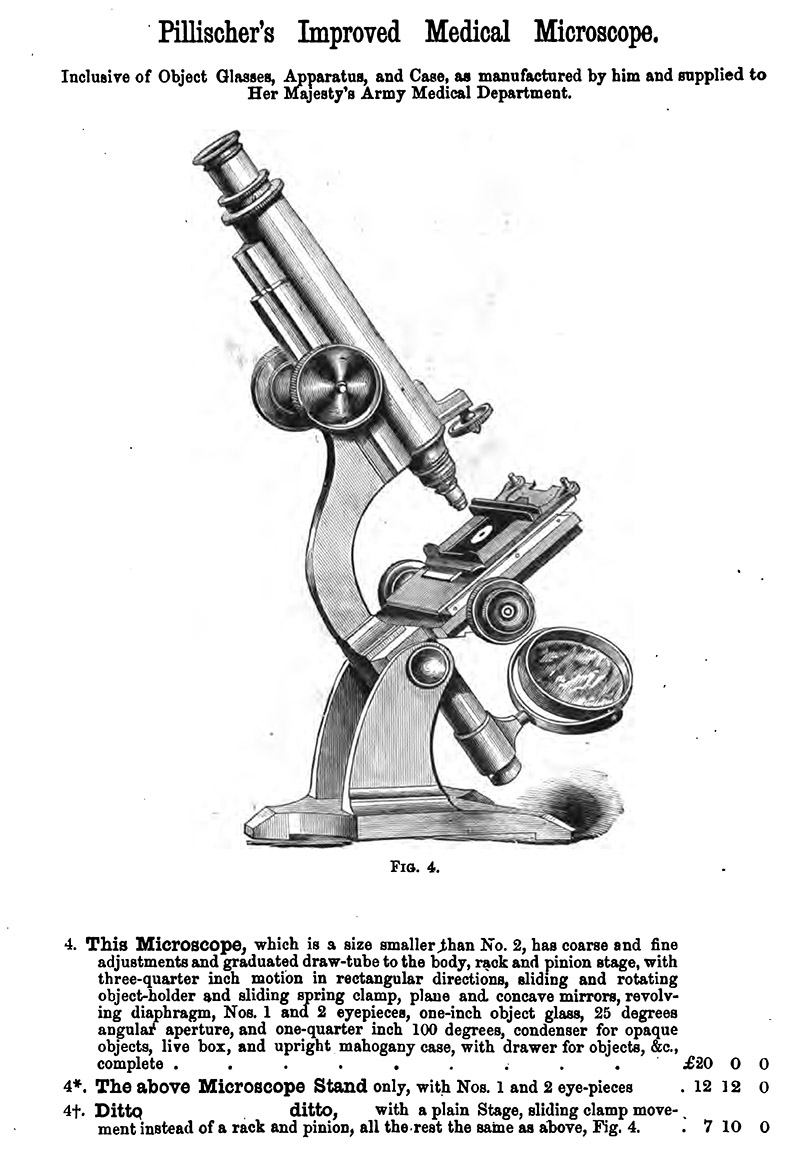

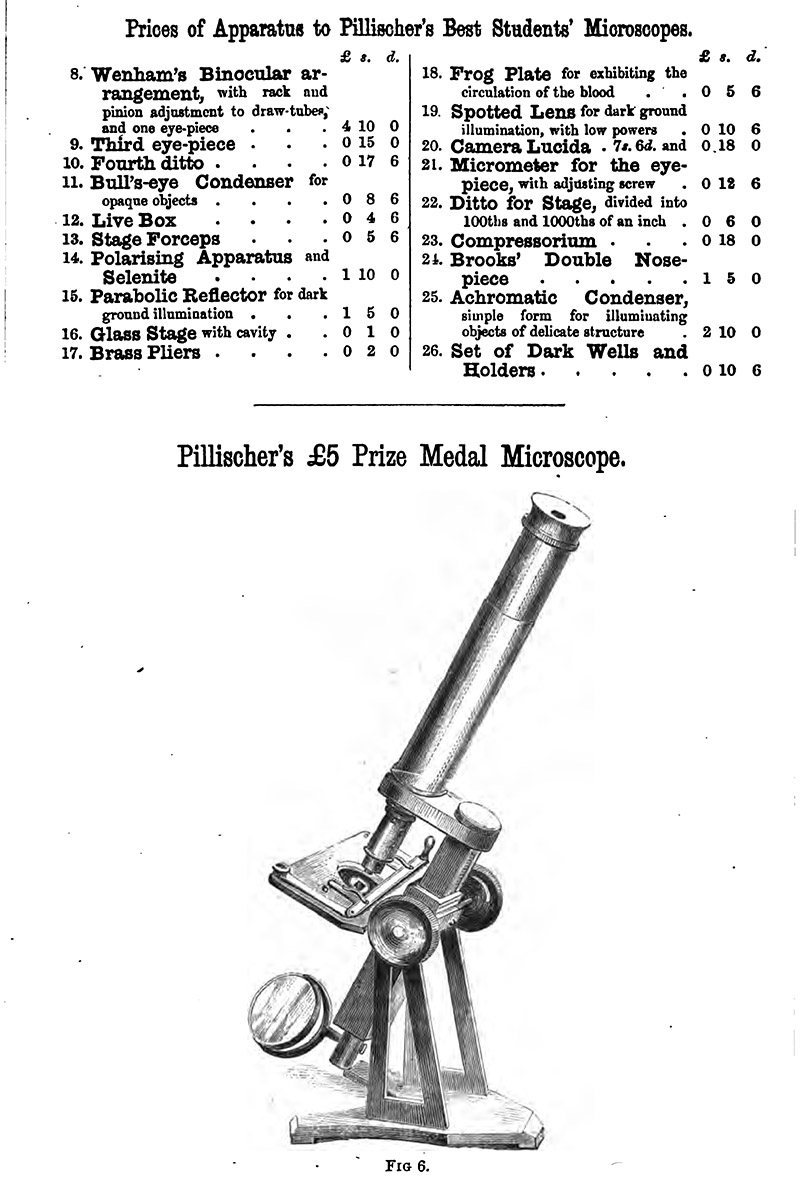
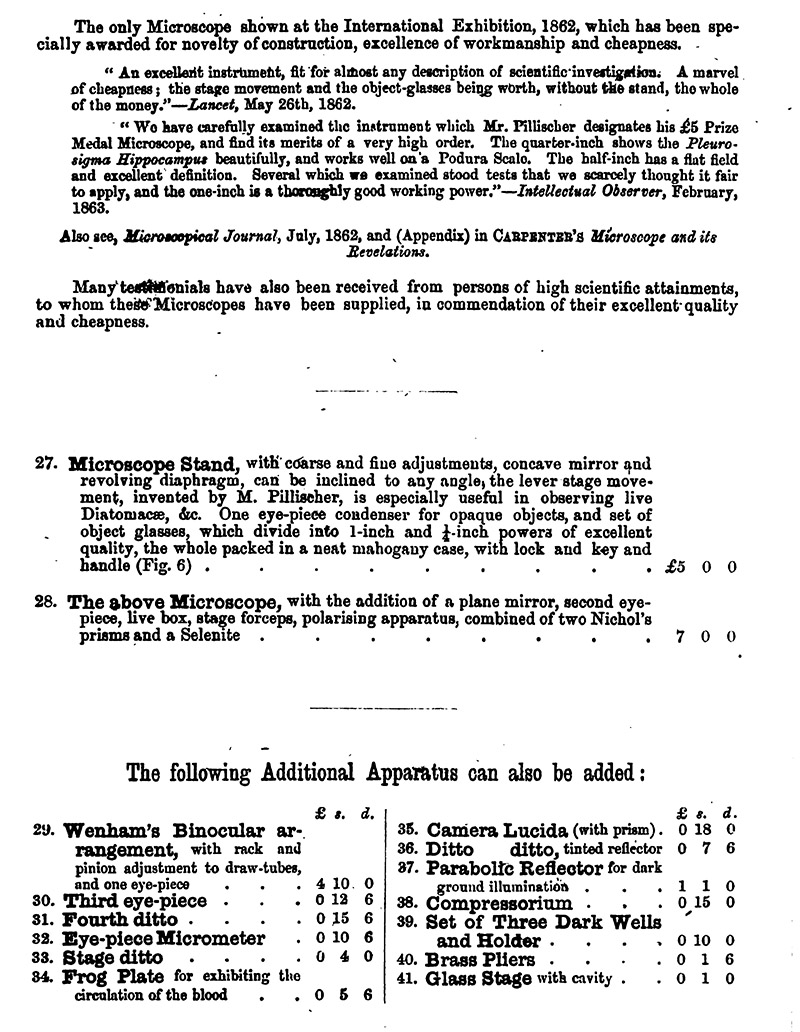
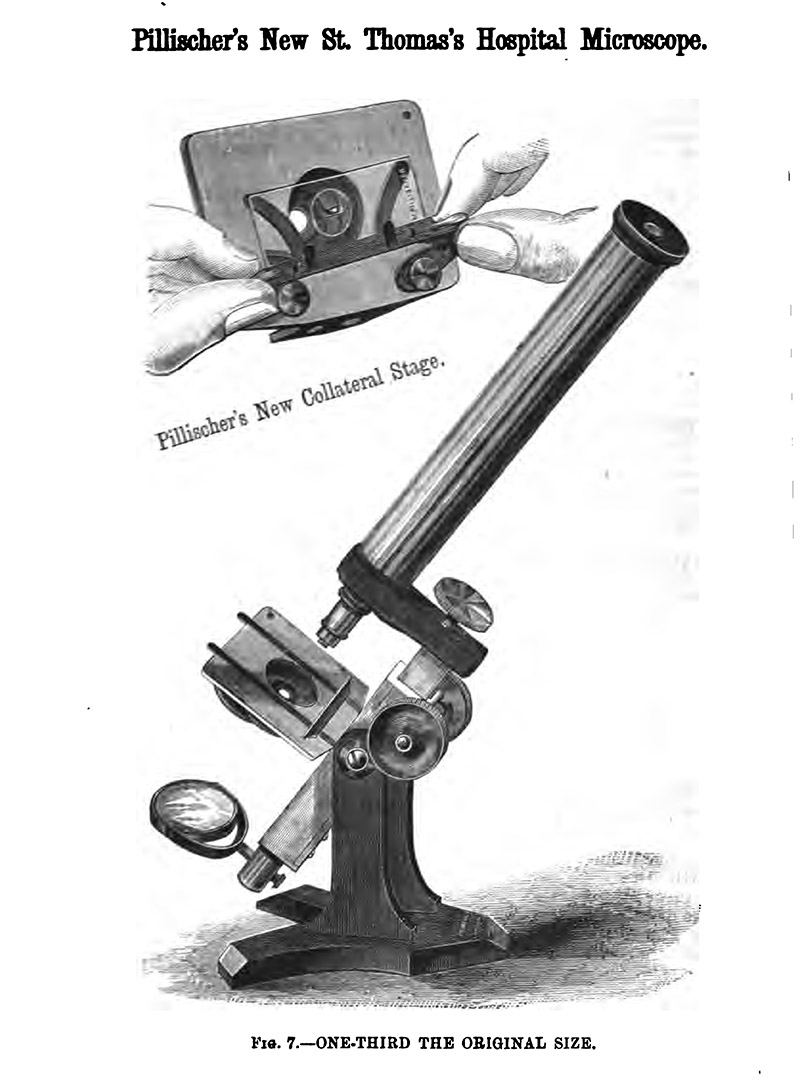
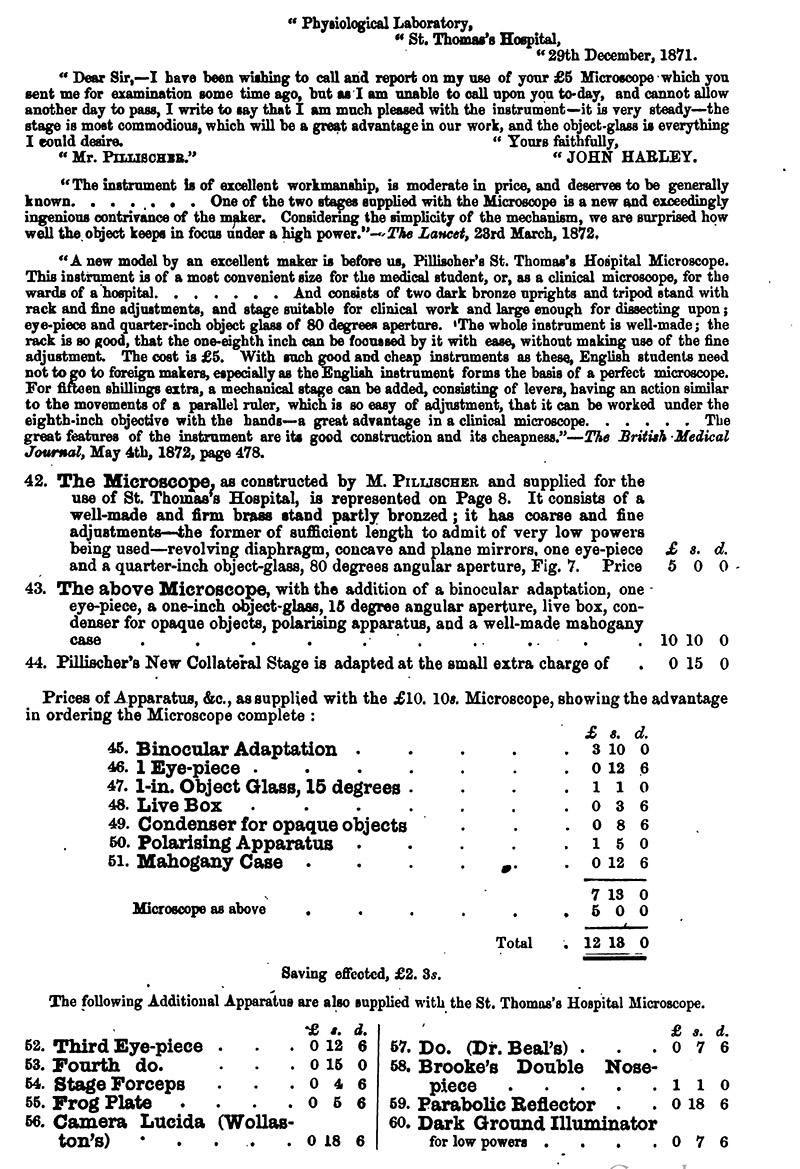
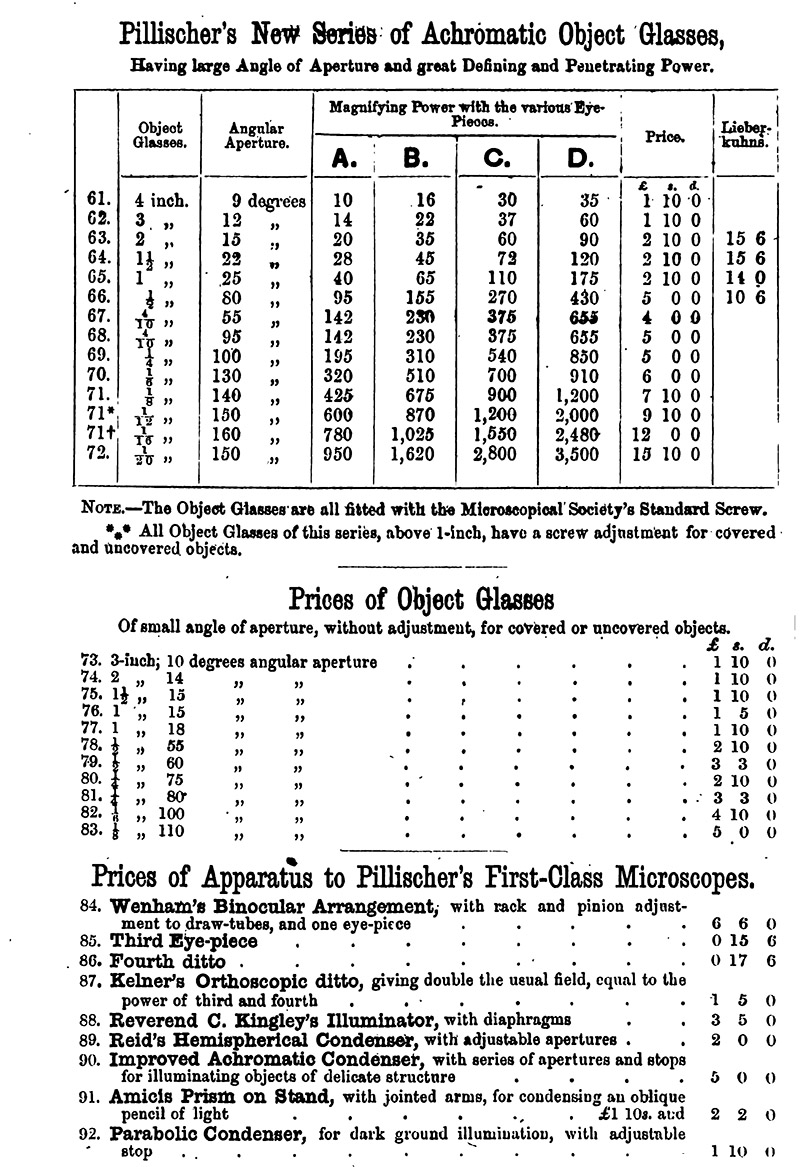
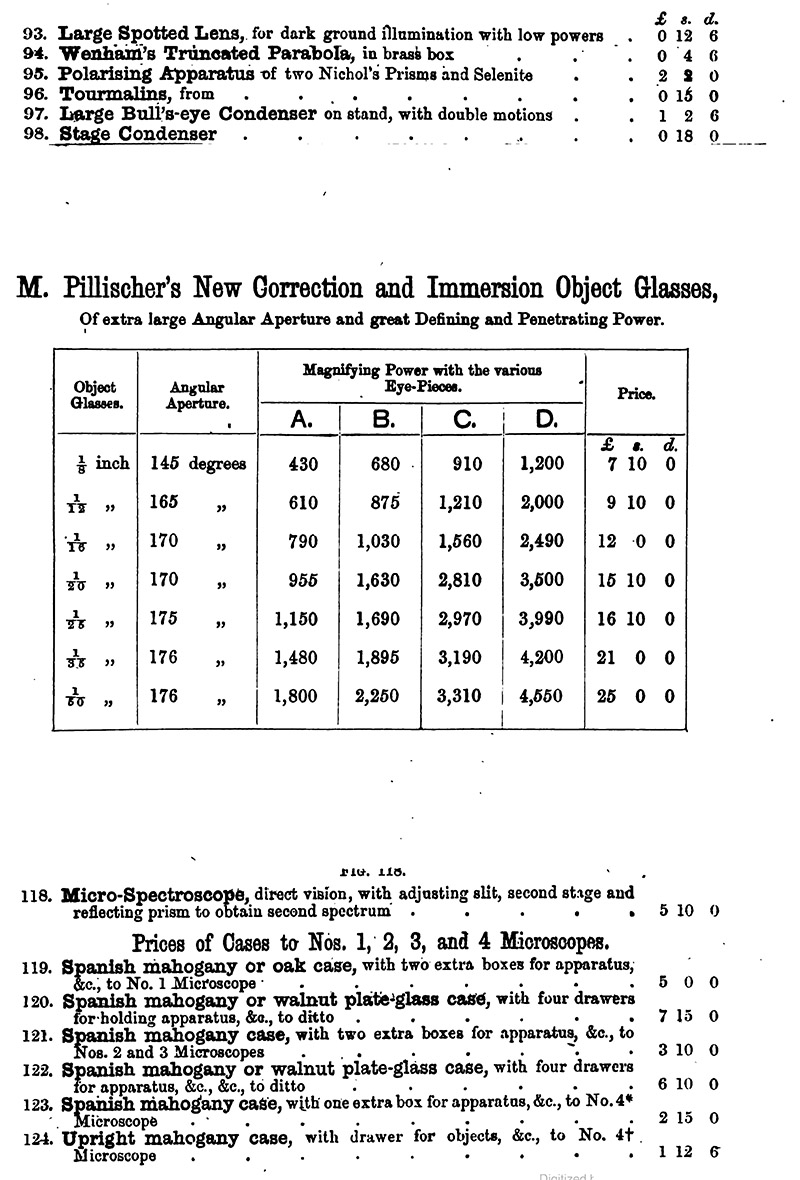
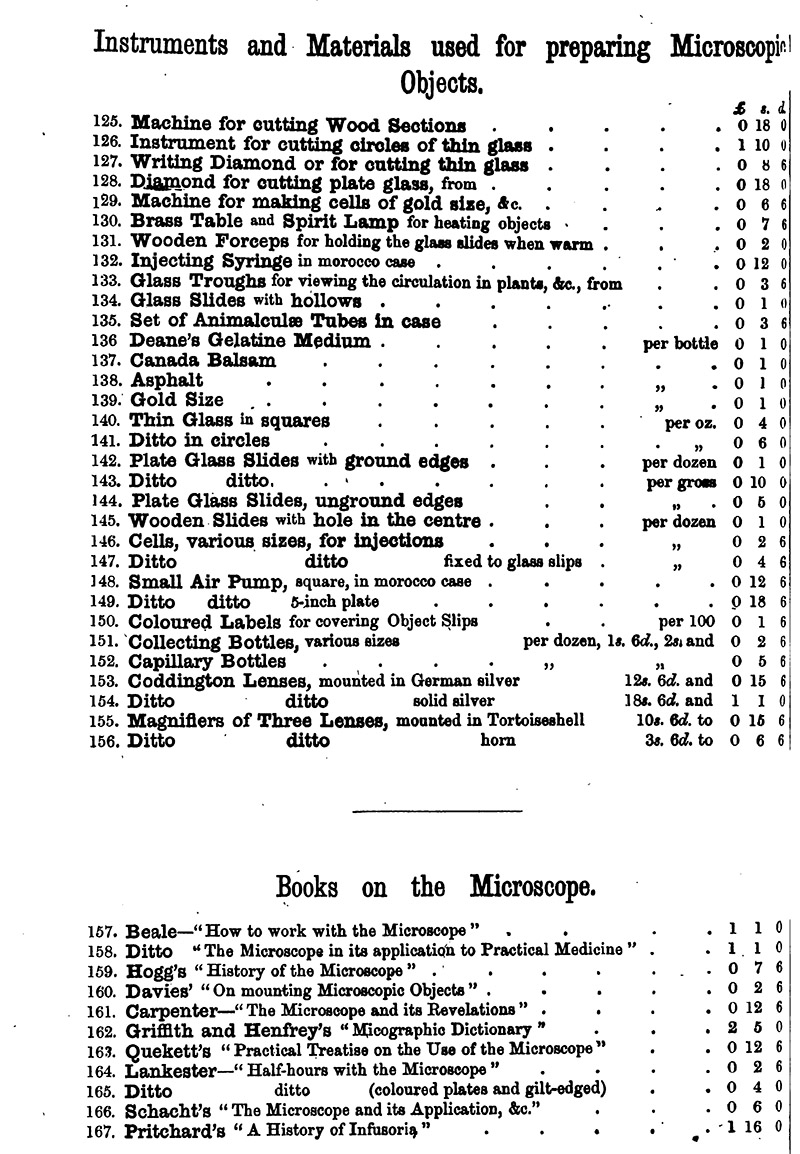
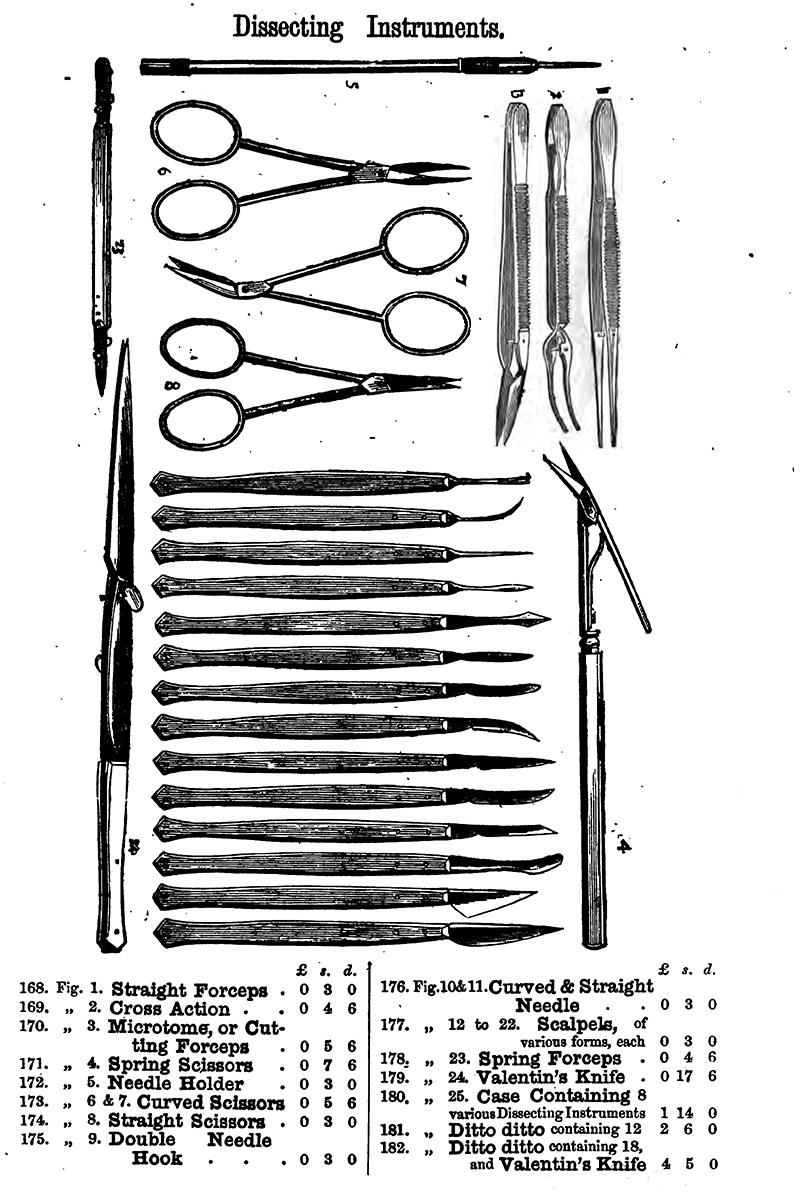
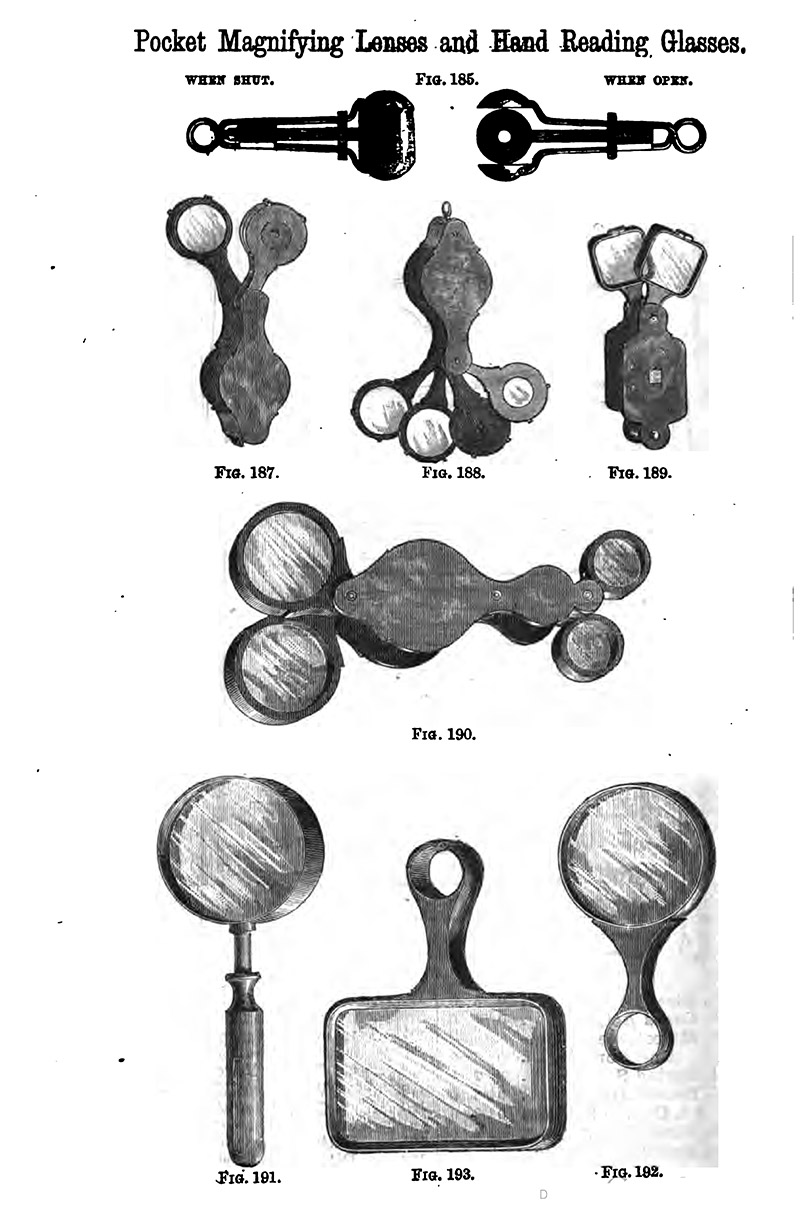
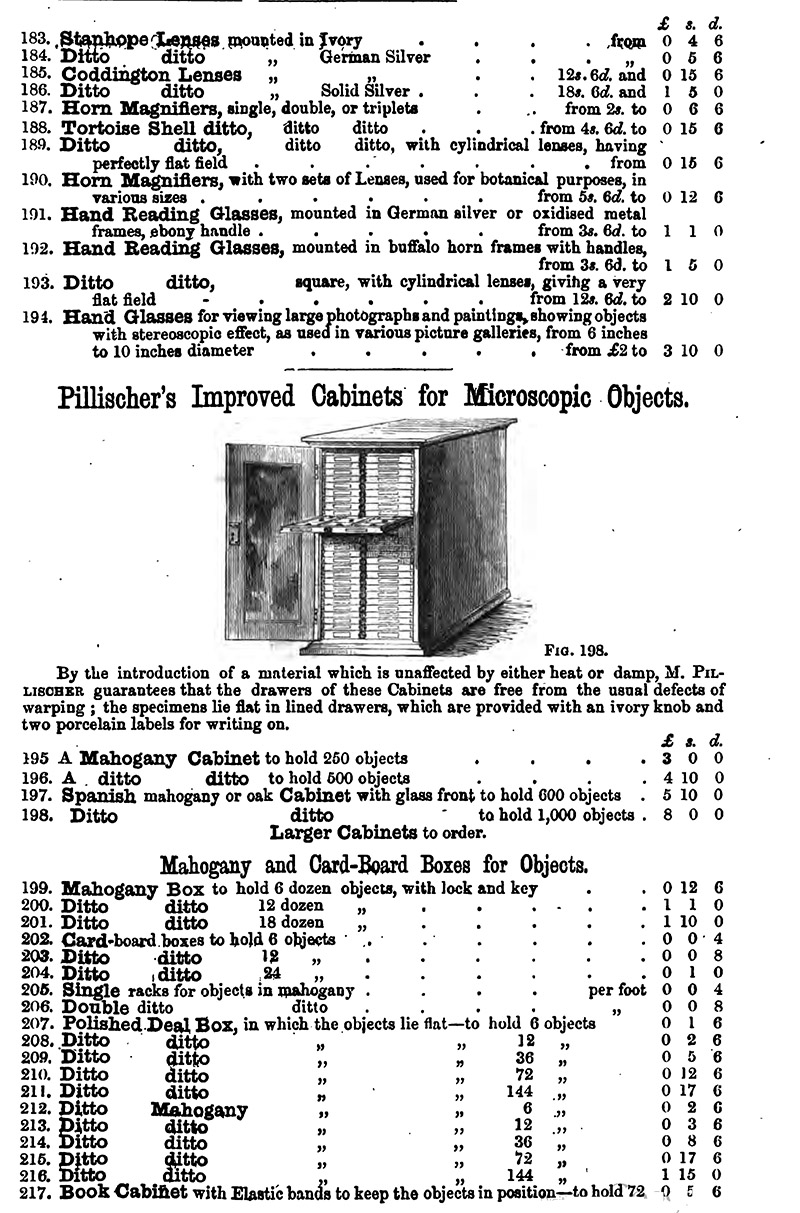
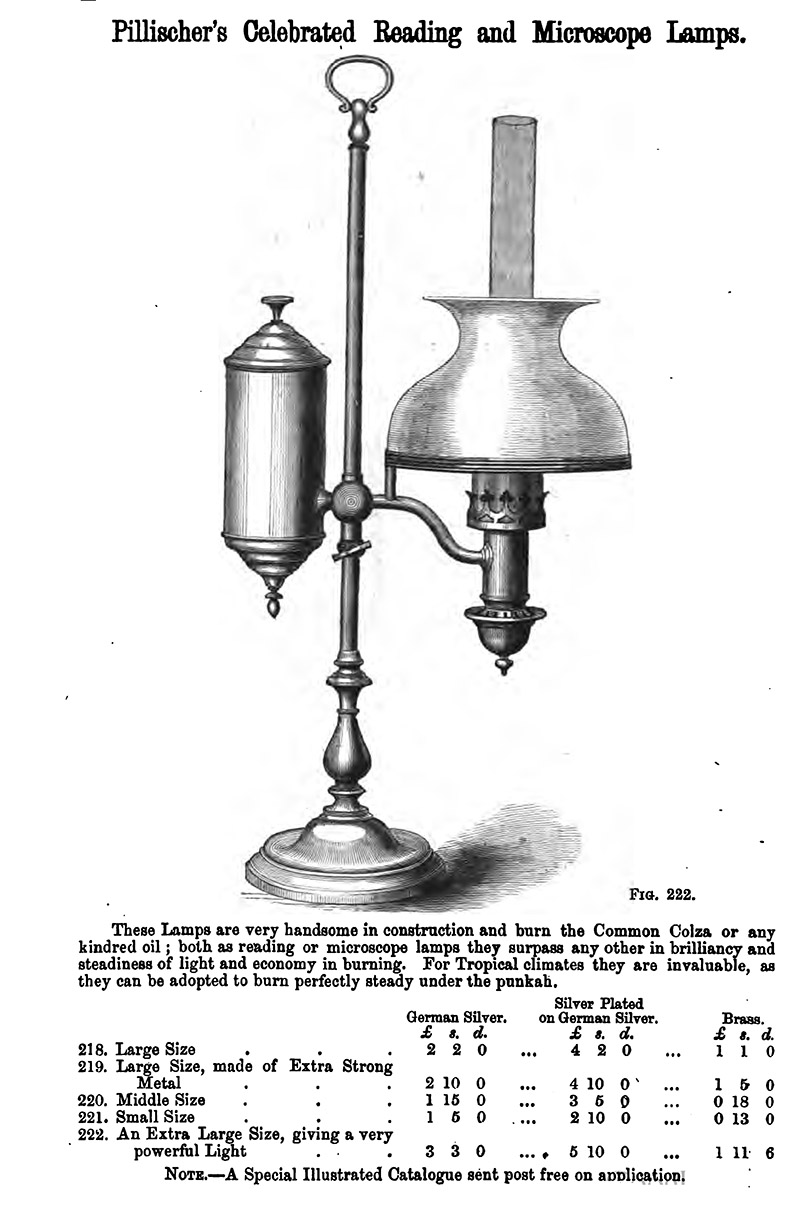
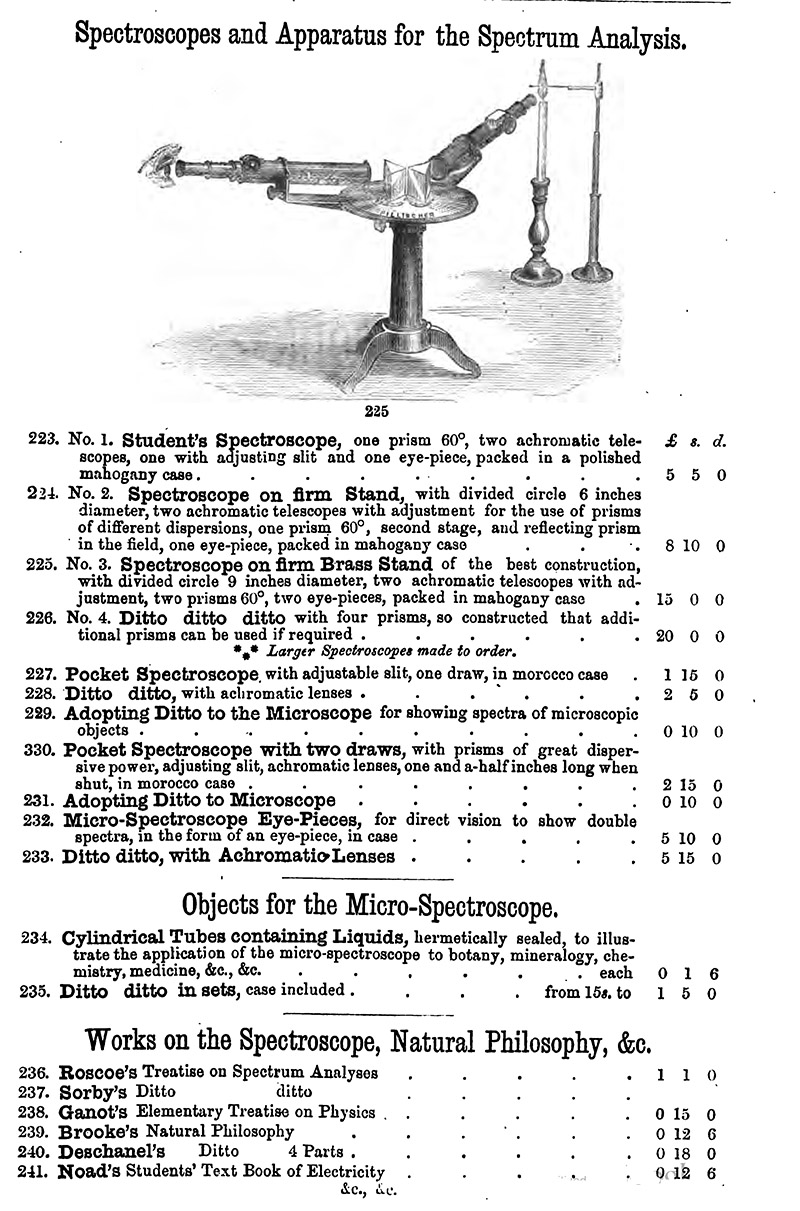
�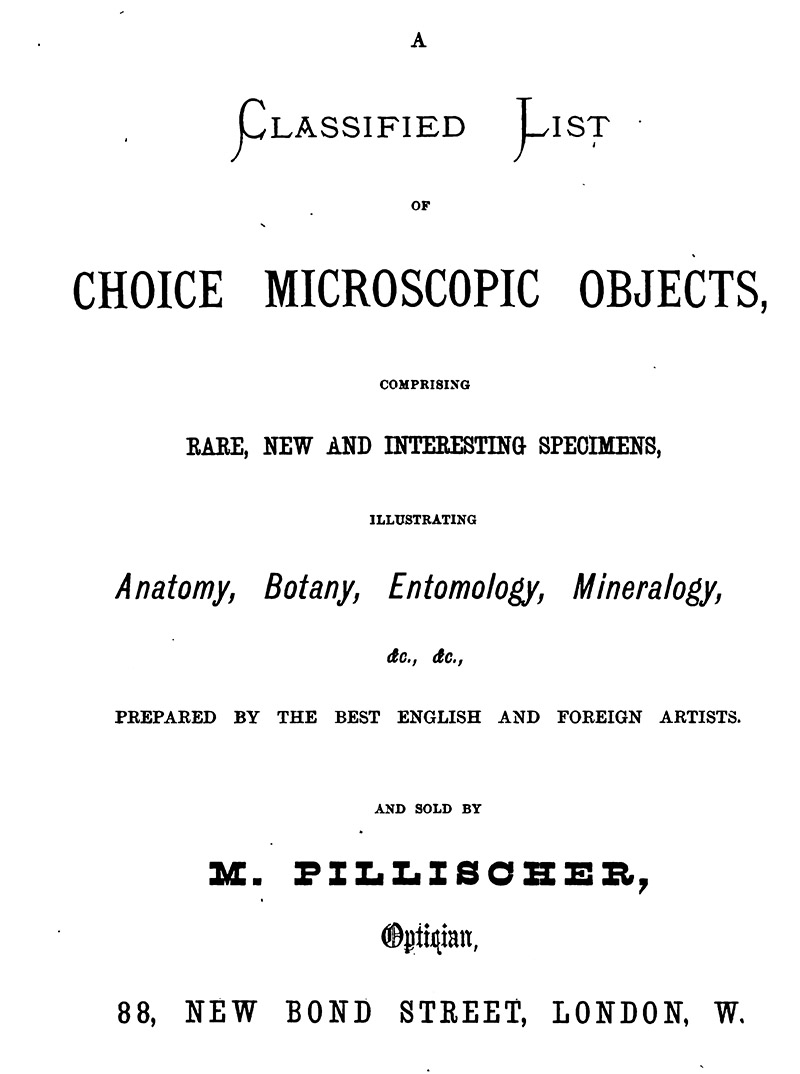
Figure 25.
Pages of microscopes from Pillischer’s 1873 catalogue.

Figure 26.
1874 advertisement from “Nature”.
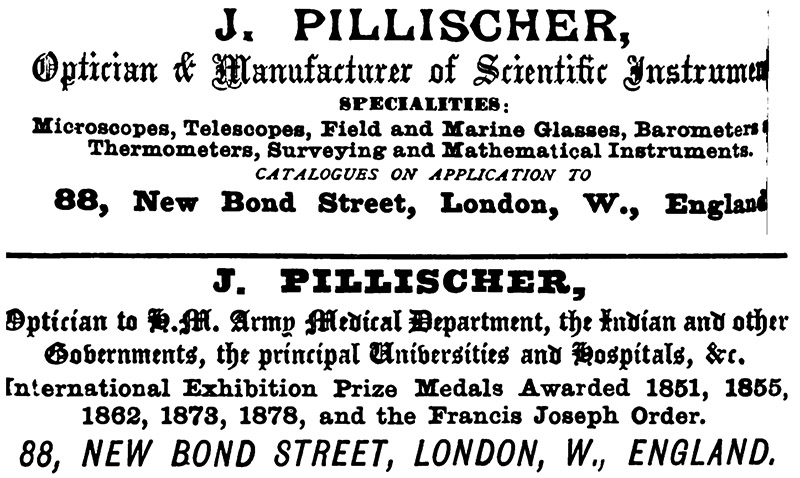
Figure 27.
1889 advertisements by Jacob Pillischer, from the Catalogue of the British Section of the Paris Exhibition.
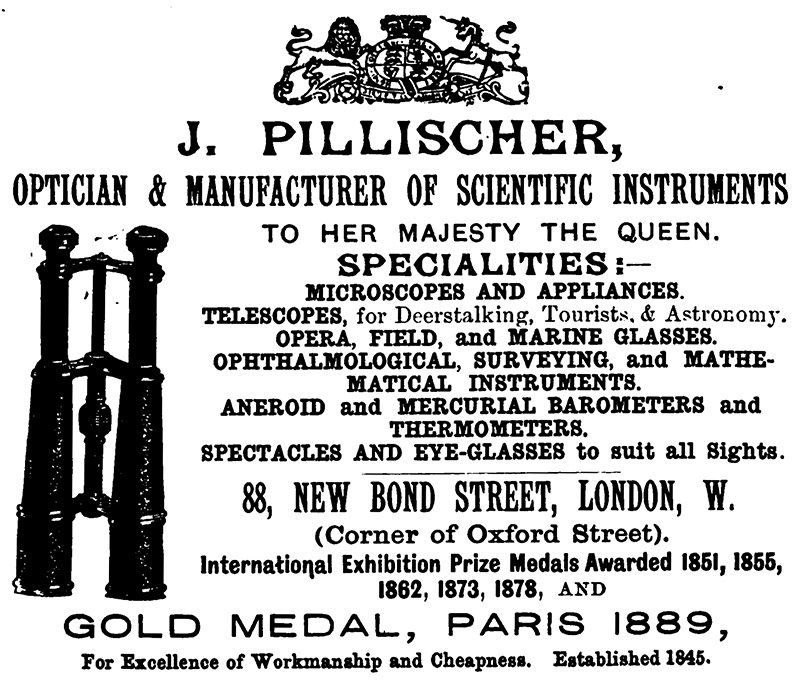
Figure 28.
An 1890 advertisement.
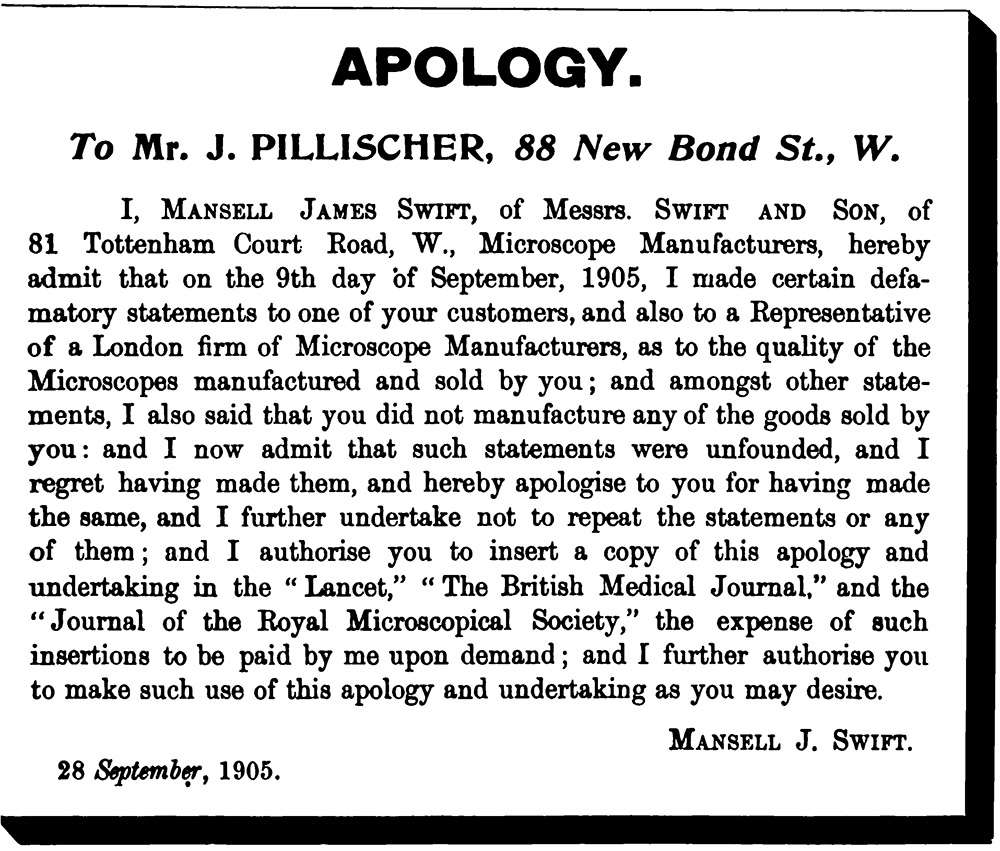
Figure 29.
Ca. 1905, Mansell J. Swift, owner of the Swift and Son optical business, slandered Jacob Pillischer, by proclaiming that Pillischer did not manufacture the items that he sold. Pillischer evidently won a judgment against Swift, the result being publication of this apology in “The Journal of the Royal Microscopical Society” and other journals.
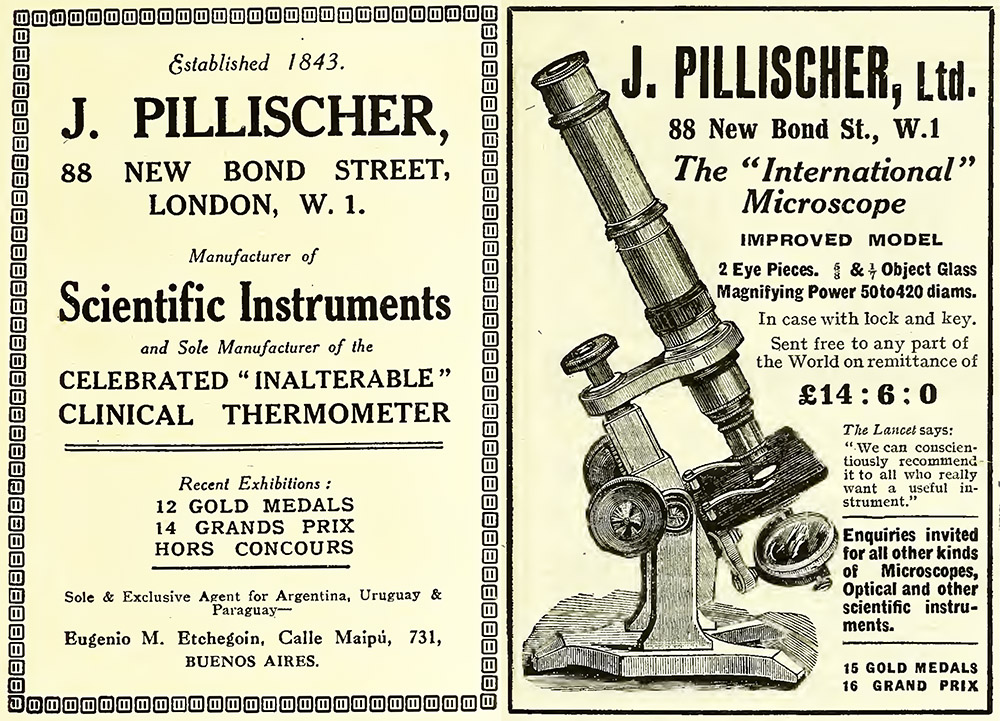
Figure 30.
Advertisements from 1920 (left) and 1930 (right). The emphasis on Pillischer’s South American agent is important because of trademark troubles he encountered in Argentina during the 1910s. The “International” microscope advertised in 1930 is essentially the same instrument that Moritz Pillischer began selling in 1876.
Acknowledgements
Thank you to Allan Wissner, Jurriaan de Groot, Barry Sobel, and Joe Zeligs for assistance in producing this essay.
Resources
The American Monthly Microscopical Journal (1890) Paris Exhibition, 1889, Vol. 11, page 90
The Art-Journal (1853) Advertisement from M. Pillischer, noting move to 88 New Bond Street, September edition, Vol. 2
The Athenaeum (1853) Advertisement from M. Pillischer, noting move to 88 New Bond Street, June 25 edition, page 755
Berger, Doreen (2004) The Jewish Victorian: Genealogical Information from the Jewish Newspapers 1861-1870, Robert Boyd Publications, Witney, Oxfordshire, pages 305 and 458
Bird, Golding (1851) Urinary Deposits: Their Diagnosis, Pathology, and Therapeutical Indications, Second American edition of the third English edition, Blanchard and Lea, Philadelphia, page 28
Bird, Golding (1853) Urinary Deposits: Their Diagnosis, Pathology, and Therapeutical Indications, Fourth edition, John Churchill, London, pages 21-22
Birth record of Deborah Pillischer (1848) accessed from the General Records Office
Bracegirdle, Brian (1998) Microscopical Mounts and Mounters, Quekett Microscopical Club, London, pages 75 and 162, and plate 29-L
Brewster, David (1855) On optical and other instruments, The Civil Engineer and Architect's Journal, Vol. 20, pages 178-184
Brookes, C. (1862) Report of the microscopes exhibited at the International Exhibition, Quarterly Journal of Microscopical Science, Vol. 4, pages 83-95
Catalogue of the Works Exhibited in the Paris Universal Exhibition (1855) page 24
Carpenter, William B. (1881) The Microscope and Its Revelations, sixth edition, J. and A. Churchill, London, pages 72-73, and advertisement at rear of the book
Chemist & Druggist (1930) Obituary of J. Pillischer, Vol. 112, page 68
Chemist & Druggist (1930) Advertisement from J. Pillischer, Vol. 112, page xxv
The Chemists’ and Druggists’ Diary (1920) Advertisement from J. Pillischer, Vol. 92, page lxxix
Ellis, Robert (1851) Official Descriptive and Illustrated Catalogue of the Great Exhibition, Vol. 1, page 437
Engineering (1873) Science exhibits at the Vienna Exposition, Vol. 16, page 116
England census and other records, accessed through ancestry.com
Frey, Heinrich (1872) The Microscope and Microscopical Technology, Translated by George R. Cutter, W. Wood & Co., New York, pages 80 and 645-647
Hogg, Jabez (1869) The Microscope, 7th edition, G. Routledge and Sons, London, pages 91-94
Illustrated London News (1851) Pillischer’s microscope, July 5, page 35
Journal of Microscopy (1898) Election of J. Pillischer to the Royal Microscopical Society, page 392
Journal of the Quekett Microscopical Club (1869) Election of M. Pillischer, Vol. 1, page 178
Journal of the Quekett Microscopical Club (1895) Election of J. Pillischer, Second series, Vol. 6, page 218
Journal of the Royal Microscopical Society (1895) Pillischer's "Lenticular Microscope", pages 353-354
Journal of the Royal Microscopical Society (1899) Instruments, Accessories, &c., pages 76-77
Journal of the Royal Microscopical Society (1902) “An Old Rackwork Draw-tube. Mr. Nelson writes to say that he was shown an old monocular Microscope fitted with a rackwork draw-tube; the tube was graduated in inches and tenths. The milled head on the pinion, which was geared to the rack, was divided into five or six equal portions by small countersunk holes, into which a springcatch pressed. When the milled head was revolved, so that the springcatch passed out of one countersunk hole into the next, the draw-tube was moved exactly one-tenth of an inch. Therefore by feeling or hearing the spring click the amount of movement given to the draw-tube would be known, without the necessity of removing the eye from the eye-piece for the purpose of reading the graduated scale. The legend engraved on the Microscope was ‘M. Pillischer, 398 Oxford Street, London. 167’.", pages 76-77
Journal of the Royal Microscopical Society (1903) Mr. Pillischer exhibited a very old Microscope which had recently been sent to him for repair, pages 245 and 542-543
Journal of the Royal Microscopical Society (1905) Apology to Mr. J. Pillischer
Kinglsey, Charles (1857) Two Years Ago, The Chesterfield Society, London, 1899 edition, pages 264-265
The Lancet (1853) Advertisement from M. Pillischer, noting move to 88 New Bond Street, July 1 advertiser
The Lancet (1873) Advertisements for Pillischer’s New St. Thomas Hospital Microscope
The Lancet (1874) Vienna exhibition, page 68
The Lancet (1876) Advertisements for Pillischer’s International Microscope
The Lancet (1887) Pillischer’s new “Kosmos” microscope, page 421
Lidstone, James T.S. (1876) Moritz Pillischer, The Londoniad, Twentieth edition, pages 84-85
The London Gazette (1947) Liquidation of J. Pillischer Ltd., Vol. 2, Page 1788
London of To-day: An Illustrated Handbook for the Season (1890) Advertisement from J. Pillischer in rear of book
Marriage record of Moritz Pillischer and Babete Cohen (1847) accessed from the General Records Office
Medical Times and Gazette (1853) The simple microscope, Vol. 27, page 85
Medical Times and Gazette (1863) Advertisement from M. Pillischer, Vol. 2, page 134
Nature (1874) Advertisement from M. Pillischer, Vol. 10, page ccxvii
Nature (1887) Notes on the January 12 meeting of the Royal Microscopical Society, Vol. 35, page 359
Official Catalogue of the Great Exhibition (1851) page 66
Official Illustrated Catalogue: Class XIII (1862) Vol. 7, pages 31-33
Official Catalogue of the British Section of the Paris Universal Exhibition (1889) Advertisements from J. Pillischer, pages 10-11
Ormerod, Eleanor A. (1894) Observations of Injurious Insects and Common Farm Pests, Simpkin, Marshall, Hamilton, Kent & Co., London, page 102
Pillischer, Moritz (1873) Illustrated Descriptive Catalogue
Pillischer, Moritz (1876) The “International”: a new microscope, The Lancet, Pages 557-558
Probate of the will of Moritz Pillischer (1893) “Pillischer Moritz of Rochfort house Albany villas West Brighton Sussex died 4 March 1893 Probate London 13 May to Julius Flachfsed stockbroker and Julius Magner hardware merchant Effects £40329 16s 8d”, accessed through ancestry.com
Quekett, John T. (1852) A Practical Treatise on the Use of the Microscope, Second edition, H. Bailliere, London, pages 98-100
Quekett, John T. (1855) A Practical Treatise on the Use of the Microscope, Third edition, H. Bailliere, London, pages 108-111, and advertisement in rear of book
Reports by the Juries (1851) William Clowes and Sons, London, page 267
Royal Microscopical Society Charter and Bye-laws: List of Fellows (1892) page 43
Woodhead, German Sims (1892) “Of the English microscopes, the following may be relied upon as of thoroughly good workmanship, and possessing good optical appliances: Pillischer's ‘International’, with five-eighths of an inch and one-seventh of an inch objectives, and two eye-pieces, price £7 10s.; a capital microscope for students. The "New International," somewhat higher in price, is also a good microscope”, Practical Pathology: A Manual for Students and Practitioners, Young J. Pentland, Edinburgh, page 34























































